Executive Summary
At the beginning of their invasion of Ukraine, Russian forces launched a relentless campaign of indiscriminate bombardments against Kharkiv, Ukraine’s second-biggest city. They shelled residential neighbourhoods almost daily, killing hundreds of civilians and causing wholesale destruction. Many of the attacks were carried out using widely banned cluster munitions.
Attacks on Kharkiv began on 24 February, the first day of the full-scale conflict. Russian forces tried to seize the city using a ground invasion force supported by massive artillery fire and missile strikes. Several residential neighbourhoods, including Oleksiivka, Saltivka, Piatykhatky, and Novi Domy, came under fire that evening.1 This initial push to take over the city failed, but parts of the city remained under heavy bombardment for two months.2 Since late April, Russian forces have been pushed back a greater distance from the city, but the shelling continues, albeit less intensely.3
Ivan Litvynyenko, age 40, told Amnesty International about one such attack, which hit the Industrialnyi neighbourhood on 15 April. Several cluster munitions exploded in a playground where he was walking with his wife Oksana and their four-year-old daughter, mortally wounding his wife.
He recalled: “When my daughter saw her mum on the ground in a pool of blood, she said to me, ‘let’s go home; mum is dead and the people are dead.’ She was in shock and so was I.” When he spoke to Amnesty International his wife was in the hospital, in dire condition. “Our world has been turned upside down,” he concluded. She later passed away.
The number of people in Kharkiv whose lives have been lost or irreparably harmed is substantial. The director of the medical department of the Kharkiv Regional Military Administration told Amnesty International that 606 civilians had been killed and 1,248 injured in the Kharkiv region between 24 February and 28 April, about 70 percent of them in Kharkiv city and the rest in the surrounding area.4 Oleh Syniehubov, the governor of Kharkiv Oblast, announced on 15 March that 600 residential buildings had been destroyed in Russian attacks since the beginning of the conflict.5
Amnesty International researchers spent 14 days in April and May investigating 41 strikes in Kharkiv, which killed at least 62 civilians and injured over 196. They visited strike locations and interviewed 160 people, including victims, survivors, relatives of victims, witnesses and doctors who treated the injured. The organisation’s researchers also collected and analysed material evidence from strike locations, notably munitions fragments which were analysed by weapons experts, as well as an array of digital investigative material. Many of those interviewed asked that their surname not be made public.6
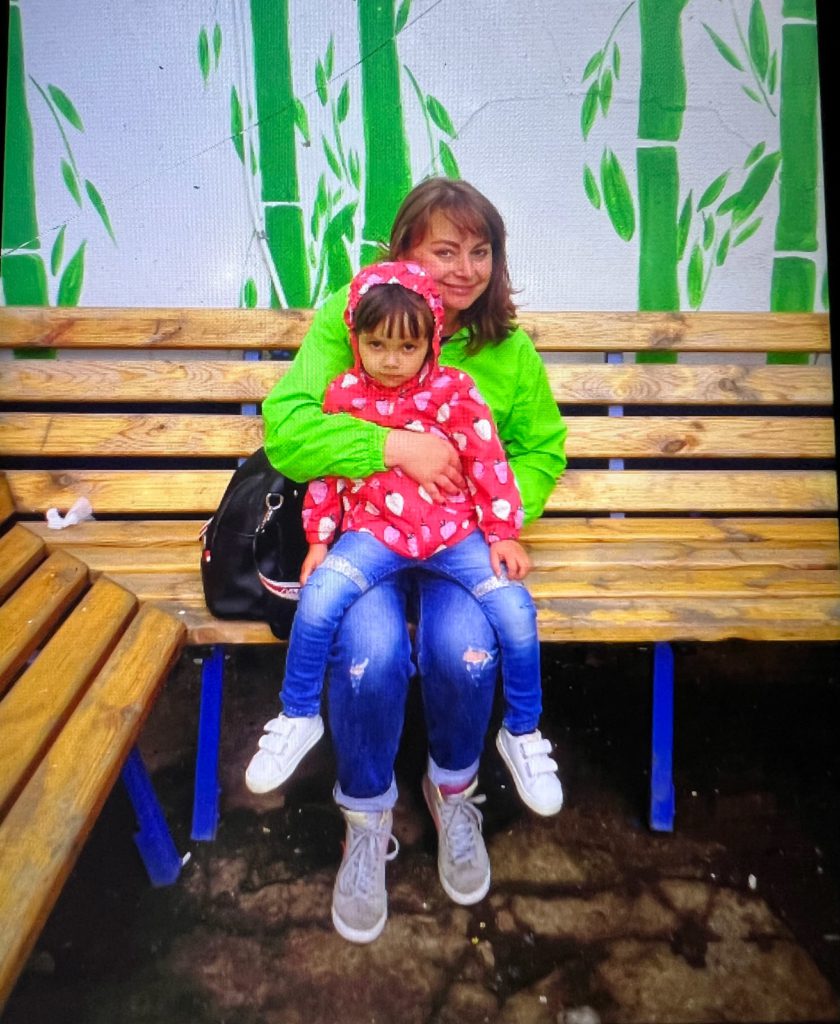
Amnesty International researchers documented seven cluster munition strikes in different neighbourhoods all over the city, where they found fins and pellets/fragments of cluster submunitions, as well as fragments of Uragan rockets known to carry such munitions. Indiscriminate attacks were also carried out using scatterable land mines and other explosive weapons, notably Grad rockets. In all, the organization documented 28 indiscriminate strikes on Kharkiv launched by Russian forces between 28 February and 30 April.
These continuing attacks have forcibly displaced hundreds of thousands of residents. A city with a pre-war population of 1.4 million people, Kharkiv emptied quickly under Russia’s brutal campaign of bombardment. On 8 March, Governor Syniehubov said that more than 600,000 civilians had been evacuated from the Kharkiv region.7 In 28 March, the mayor of Kharkiv estimated that about 30 percent of the city’s population had left, with the exodus continuing in April.8 Many of the families who stayed were forced to take refuge underground, hiding in school basements, subway stations, and other ad hoc shelters.
The repeated bombardments of residential neighbourhoods in Kharkiv are indiscriminate attacks which killed and injured hundreds of civilians, and as such constitute war crimes. This is true both for the strikes carried out using cluster as well as those conducted using other types of unguided rockets and unguided artillery shells, which are indiscriminate when used in the vicinity of concentrations of civilians. The continued use of such inaccurate explosive weapons in populated civilian areas, in the knowledge that they are repeatedly causing large numbers of civilian casualties, may even amount to directing attacks against the civilian population.
Amnesty International calls for justice processes to be as comprehensive as possible, ensuring that all perpetrators are brought to justice through independent, impartial, and fair trials for all crimes under international law.
Background
On the first day of the invasion, Russian troops crossed the Ukrainian border — only 26 km from northern areas of Kharkiv at its nearest point — and drove along the main roads to the city, where they met stiff Ukrainian resistance. Fierce fighting took place on the city’s northern outskirts.9 Official Ukrainian sources reported that on the morning of 27 February Russian troops had reached Kharkiv’s city centre and that heavy fighting was taking place, but later that day they said that Ukrainian forces were again in control of the city.10 Russian paratroopers reportedly entered the city again on 2 March, but they failed to establish a foothold there, falling back to battle Ukrainian forces in the villages north and east of the city.11
Neighbourhoods in the northeast of Kharkiv, such as Saltivka, a densely built-up residential area where a significant percentage of residents remained in their homes in high-rise buildings, have been subject to particularly frequent shelling.12
By early May the shelling of the city subsided as Russian forces withdrew towards the border, and Ukrainian forces retook control of some of the villages between Kharkiv and the border which had previously been occupied by Russian forces.13
Cluster munitions strikes
Russian forces have repeatedly launched devasting and indiscriminate strikes using internationally banned cluster bombs on populated residential areas, killing and injuring scores of civilians. In barrage after barrage, men, women and children have been killed
and injured in their homes and in the streets, in playgrounds and cemeteries, while queueing for humanitarian aid or shopping for food.
At least nine civilians were killed and more than 35 injured — including several children — when Russian forces rained down cluster munitions in and around Myru Street in the Industrialnyi neighbourhood, southeast of the city centre. The attack took place on the afternoon of 15 April 2022, and it blasted an area of over 700 square metres. Doctors at City Clinical Hospital 25 told Amnesty International that 31 injured people were brought to the hospital, two of whom died of their wounds, in addition to seven people who were killed on the spot. Several other wounded civilians were reportedly taken to other hospitals.14 The injuries doctors saw included penetrating wounds to the abdomen, chest and back. Doctors showed Amnesty International metal fragments they had removed from patients’ bodies, which matched the types of pre-formed pellets found in 9N210/9N235 cluster munitions -- weapons that have been repeatedly used by Russian forces.15 Some of the victims were killed or injured in the courtyards between buildings, others in the surrounding streets and nearby parks.
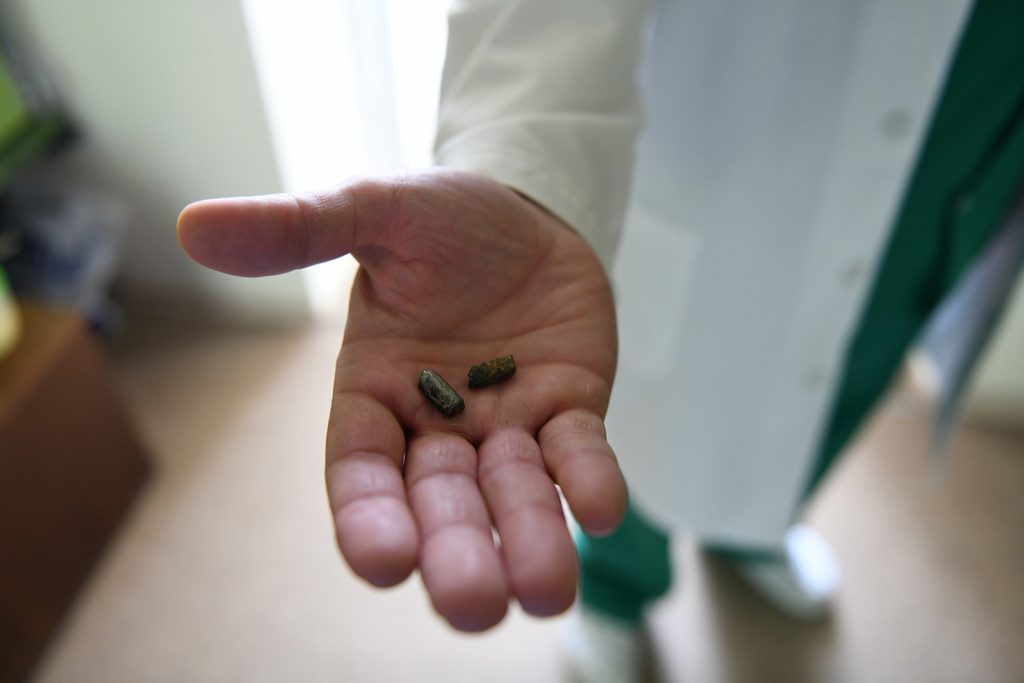
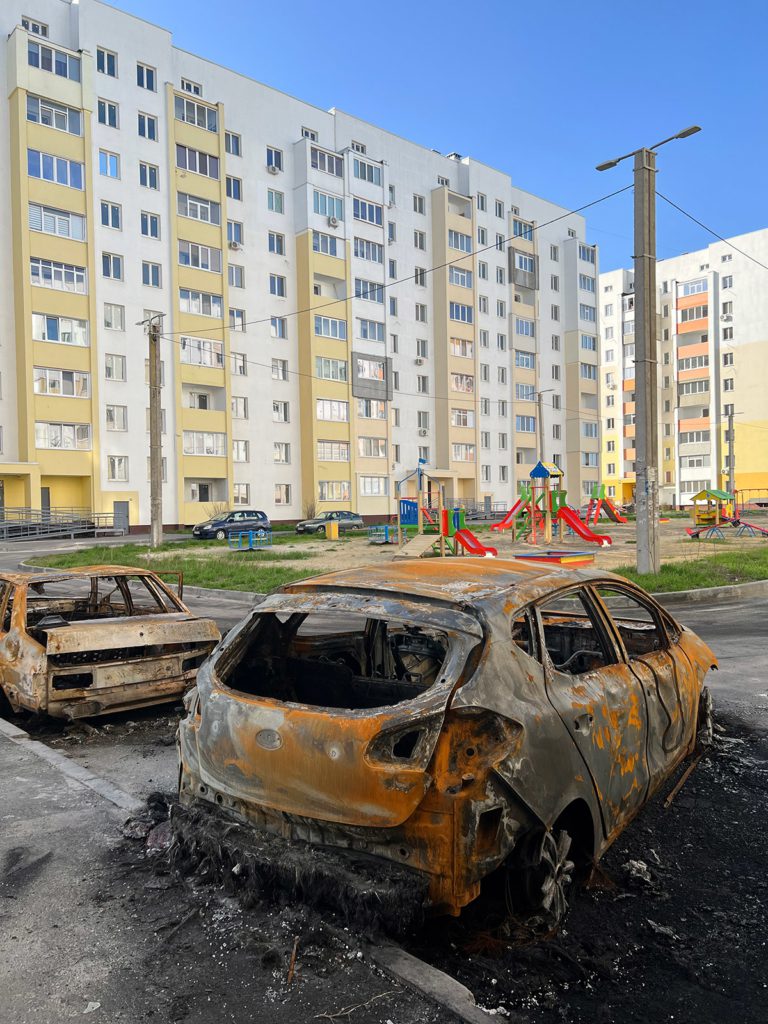
Tetiana Ahayeva, a 53-year-old nurse, told Amnesty International that she was standing by the entrance of her building with some neighbours enjoying the warm sunshine – a welcome break from long spells in the basement shelter – when several cluster bombs exploded near her:
There was a sudden sound of firecrackers everywhere, lots of them, all over. I saw puffs of black smoke where the explosions occurred. We dropped to the ground and tried to find cover. Our neighbour’s son, a 16-year-old boy called Artem Shevchenko, was killed on the spot. He had a hole 1 cm wide in his chest. His father had a shattered hip and a shrapnel wound in his leg.It’s hard to say how long the explosions lasted; a minute can seem to last forever. As soon as the explosions stopped we tried to get to our building. My son said he felt weak so my neighbor helped him inside.
Tetiana Ahayeva
Tetiana Ahayeva’s 18-year-old son Ilkham sustained deep abdominal injuries. Doctors at the hospital showed Amnesty International two metal pellets that they had removed from Ilham’s abdomen. These pellets match the longer 4.5 gram pellets found in 9N235 cluster munitions. Another neighbour, Bohdan Burlutsky, age 28, was injured as he parked his car in front of his building across the road, where several cluster munitions exploded all over the courtyard, setting several cars on fire and injuring other neighbours.
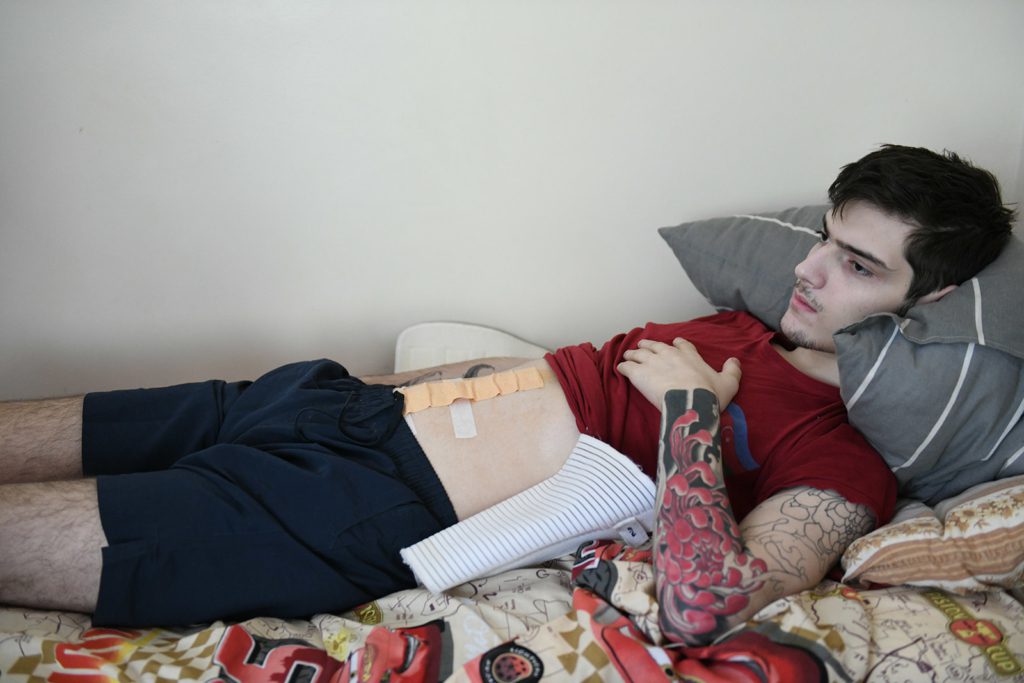
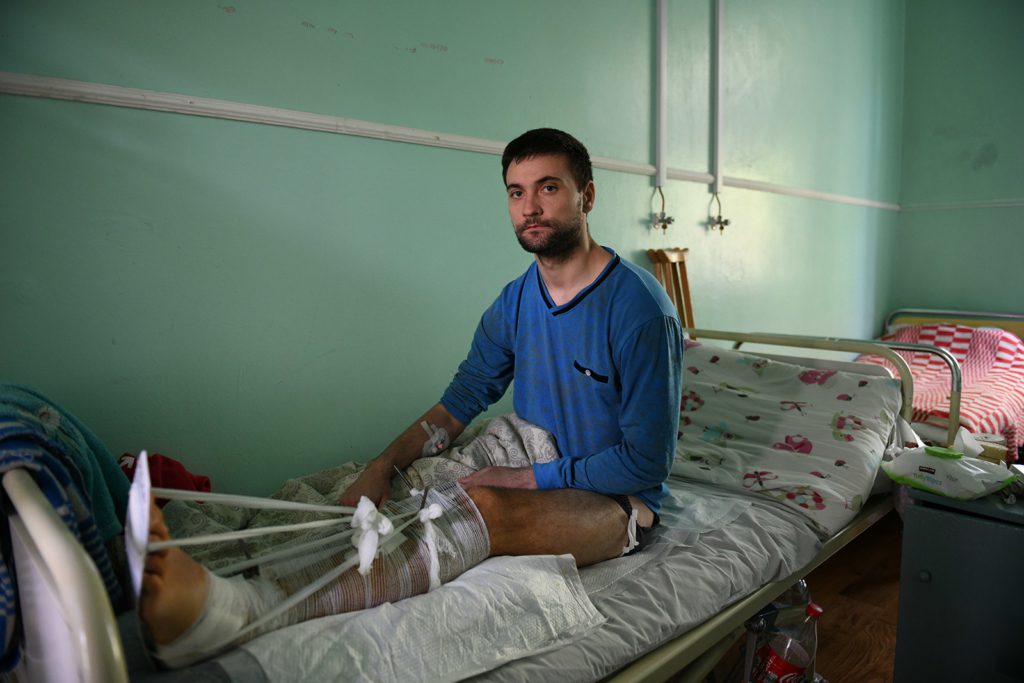
Another resident of the building, Oleh, told Amnesty International that his neighbour Oleksandr Hamara, age 35, who had recently moved to the building, was among those killed in the yard.
In the nearby playground off Myru Street, Oksana Litvynyenko, a 41-year-old mother of two, suffered devastating injuries when several cluster munitions exploded near where she was walking with her husband and their four-year-old daughter. Shrapnel penetrated her back, chest and abdomen, puncturing her lungs and damaging her spine. Oksana tragically died on 11 June. Her husband Ivan Litvynyenko, age 40, told Amnesty International on 26 April 16:
At the nearby Hulliver Park, Olha Sadovska, age 65, was sitting on a bench with her husband when several cluster munitions exploded, injuring her and others around her. She recalled:
My husband and I went out for a stroll in the park next to our house. It was crowded. There was a ping pong table, with boys playing ping pong. We sat down on a bench. Within seconds, there was an explosion. All the boys playing ping pong fell. Then multiple explosions. A man yelled, “get down!” We hit the ground, then I saw blood was oozing from my leg.
Olha Sadovska
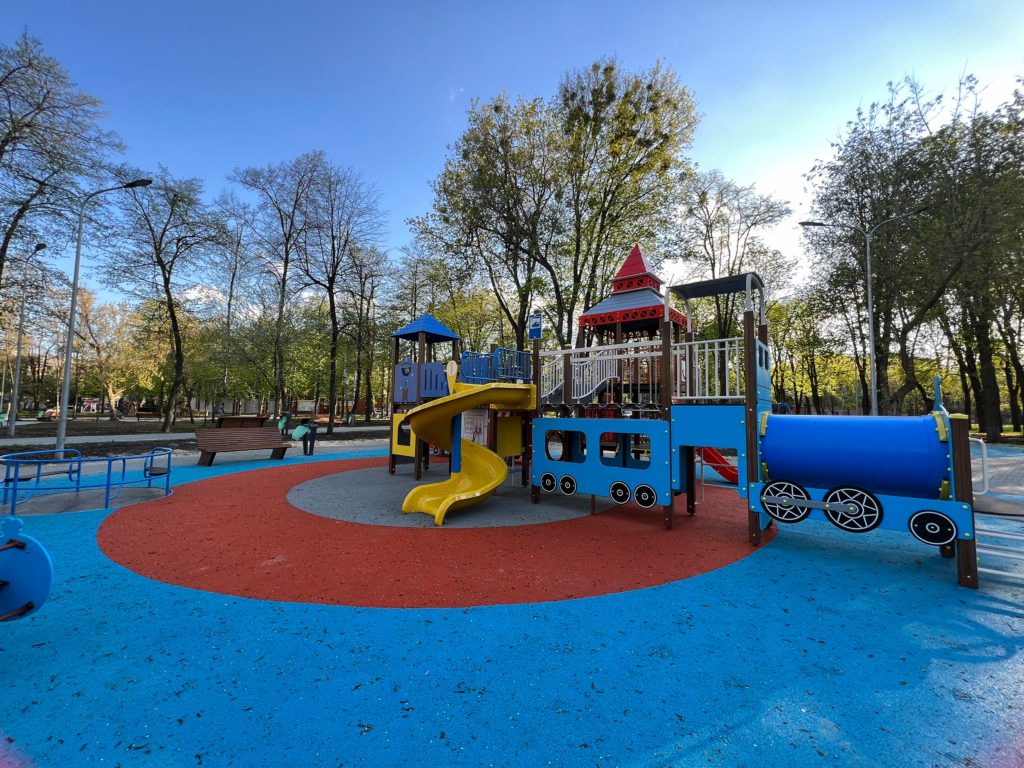
All over the area Amnesty International researchers found the distinctive black fins and metal pellets from 9N210/9N235 cluster munitions, as well as craters with symmetrical spalling, consistent with the expected damage and fragment pattern from the explosion of these munitions.
Strikes in places where people were queuing for humanitarian aid
At least six people were killed and some 15 injured when cluster munitions struck a parking lot outside the post office near the Akademika Pavlova metro station, raining down shrapnel where hundreds of people were queuing for humanitarian aid in the morning of 24 March.17
Valeriia Kolyshkina, a sales assistant in a pet food shop 150 metres east of the post office, told Amnesty International that a man was killed just outside the shop. One of the cluster munitions exploded a few metres to the right of the store, shattering the glass front of a nearby store. Valeriia Kolyshkina recalled hearing the loud noise of glass smashing and people screaming and running into the shop while the shop owner told people to lie down.
She described the scene:
A man was killed just outside the shop. He was standing outside smoking while his wife was buying pet food. He was about 50 to 60 years old. Metal shrapnel came through the front window flying over my head as I was behind the counter. Then there were several more explosions. It was utter panic. The shop was full of people. We ran to the storage room at the back of the shop for protection. It was very scary. (I consider that day as my second birthday, I thought I would die.)
Valeriia Kolyshkina
“There were a lot of people in the parking lot,” recalled Ruslan, a policeman, describing the scene on the northern side of the parking lot, where people were waiting in line for the delivery of humanitarian assistance. More civilians were also waiting in line at the entrance of a supermarket 120 meters further south, where another explosion occurred. “It was really a horrible situation,” said Ruslan. “Shrapnel was falling like rain.” Civilians ran for cover in panic in the direction of the shops east of the parking lot while cluster munitions went off.
Several people were injured near the entrance to the Akademika Pavlova metro station, on the western edge of the parking lot. Ruslan was in his car, preparing to leave alongside Sadagad and Dmitry – two other policemen – after they had finished their shift at the metro station, where many civilians had found refuge in the previous month. Also sitting in the car were 13-year-old Oleksandr, Dmitry’s brother, and their mother Olena.
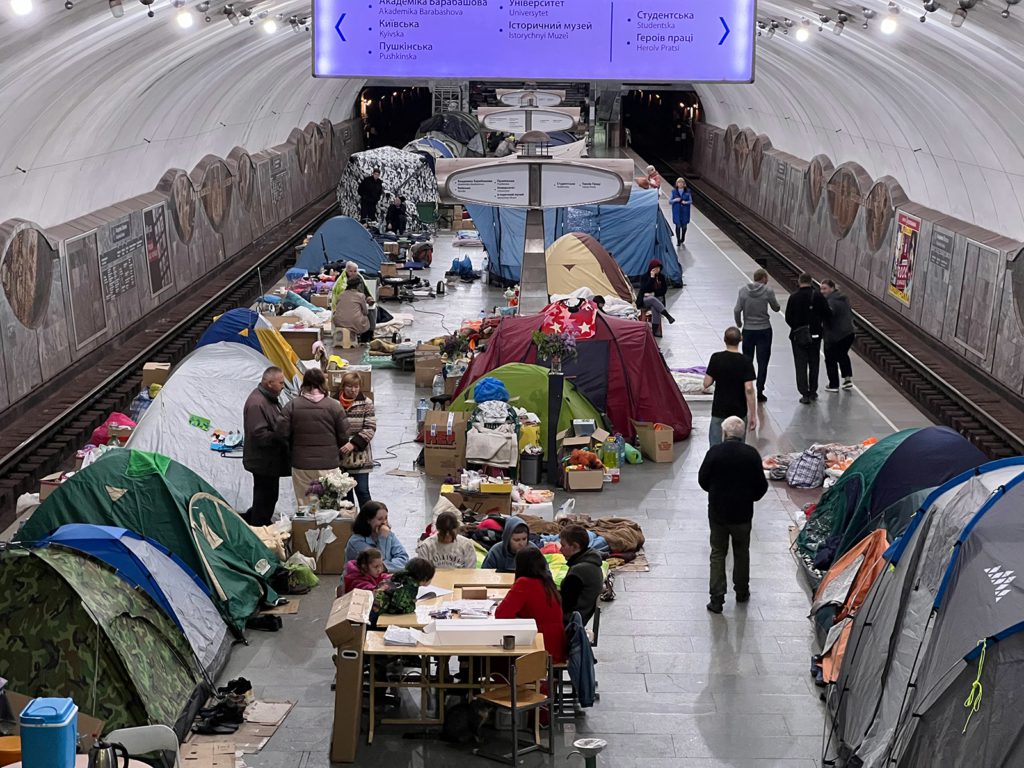
Shrapnel hit Sadagad, who was outside the car, severely injuring his right arm and leg. A blast knocked over Olena while she was running for cover with Oleksandr towards the metro station. As Oleksandr ran back to help his mother, a cluster munition exploded near the entrance to the station, injuring him in the left foot. “I think he survived because he came back to me, because the shelling was very close to the metro entrance,” said Olena. Ruslan also suffered shrapnel injuries to his right foot and leg.
Ruslan and Dmitry rushed to drag Oleksandr and Sadagad, who were too injured to walk, into the metro station. Ruslan applied an improvised tourniquet to Sadagad to stop the bleeding. Alongside Oleksandr, the pair received first aid in the station before being transferred to Kharkiv military hospital. As of mid-May 2022, both Sadagad and Oleksandr remain in recovery: Oleksandr is in a wheelchair and lost sensation in his left foot, while Sadagad, who suffered from multiple fractures and damage to his vessels from the shrapnel, remains hospitalized.
While many of the cluster munitions exploded in the parking lot, others exploded hundreds of metres away. Sasha, a 45-year-old post office employee, told Amnesty International that he was at work when an explosion was heard in the area and people fled:
I had just got on my bike when I heard another explosion followed by many smaller explosions. I fell off my bike and felt pain and I knew that I was injured. I was bleeding a lot. I ran to a nearby building, carrying my bicycle. (I had taken a loan to buy my bicycle so I did not want to leave it behind even if [it was] broken.) I was wounded in the chest and the left arm. An ambulance took me to hospital. I had a small axe in my backpack and it saved my life. Two pieces of shrapnel struck it, which prevented them from penetrating into my body.
Now I am too scared to go out or to stay anywhere above ground. So I’m not staying in my apartment; I’m living in the metro station. I can’t get over the fear.
Sasha
Two other cluster munitions went through the roof of the Holy Trinity Church, 500 metres away from where the rocket landed. The church also serves as a humanitarian hub and it is busy all day with volunteers preparing food and aid packages to be distributed to older people and those with disabilities and reduced mobility who cannot go and queue at humanitarian assistance distribution points. Pastor Petro Loboiko and Pastor Serheii Andreiivich showed Amnesty International shrapnel from two cluster munitions which exploded on the roof of the church, penetrating through to the rooms and hallway where minutes earlier a dozen people had been standing. Shrapnel from the munitions penetrated the walls and doors, damaging adjacent rooms, and the explosion damaged the ceiling of the floor below, where humanitarian aid is stored and packaged for distribution.
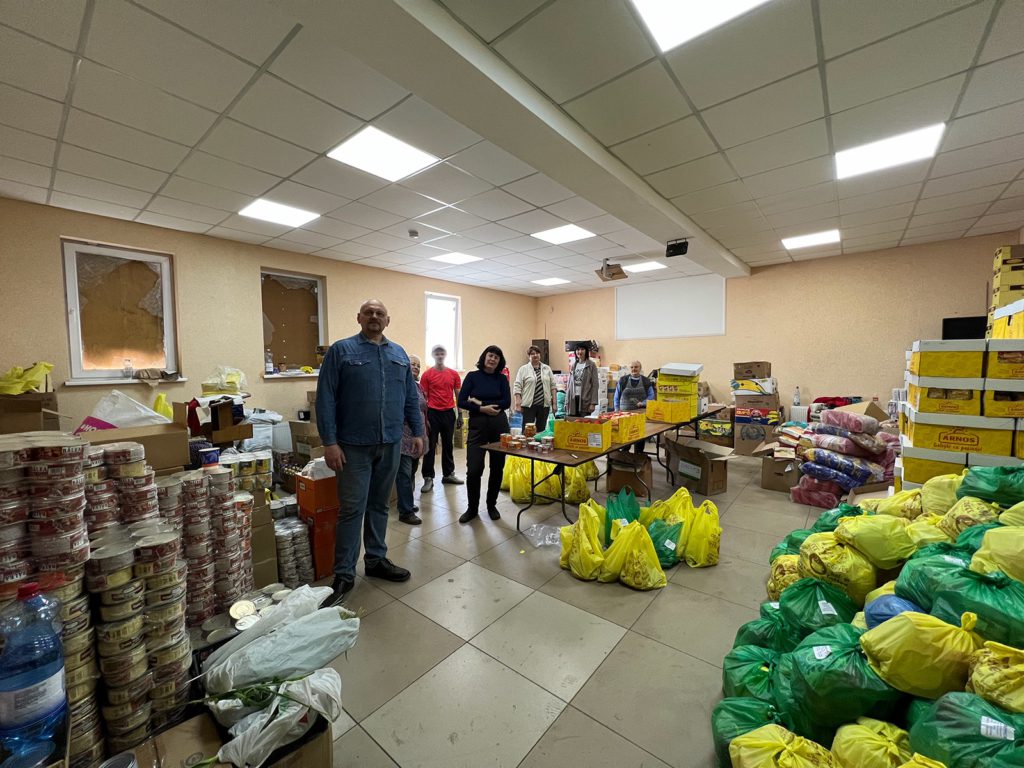
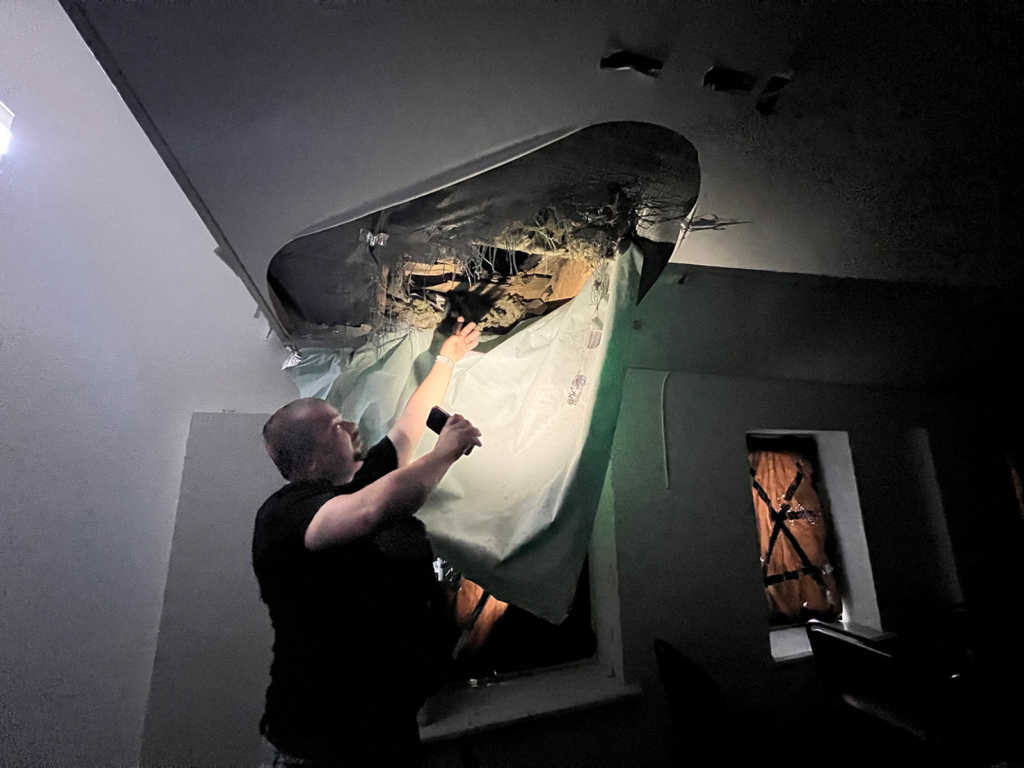
In front of the post office Amnesty International researchers found parts of a 220mm Uragan rocket, which carries 30 cluster munitions, still embedded in a crater in the tarmac. And all over the area they found fins and pellets and other fragments from 9N235/9N210 cluster munitions, as well as small craters where the munitions exploded.
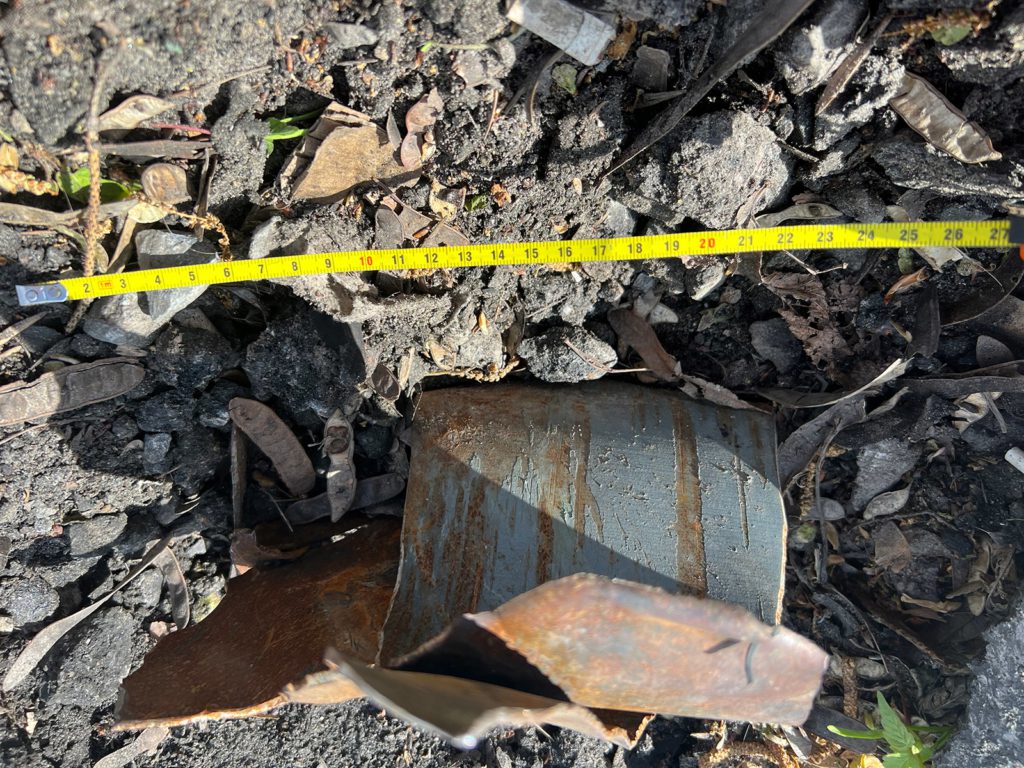
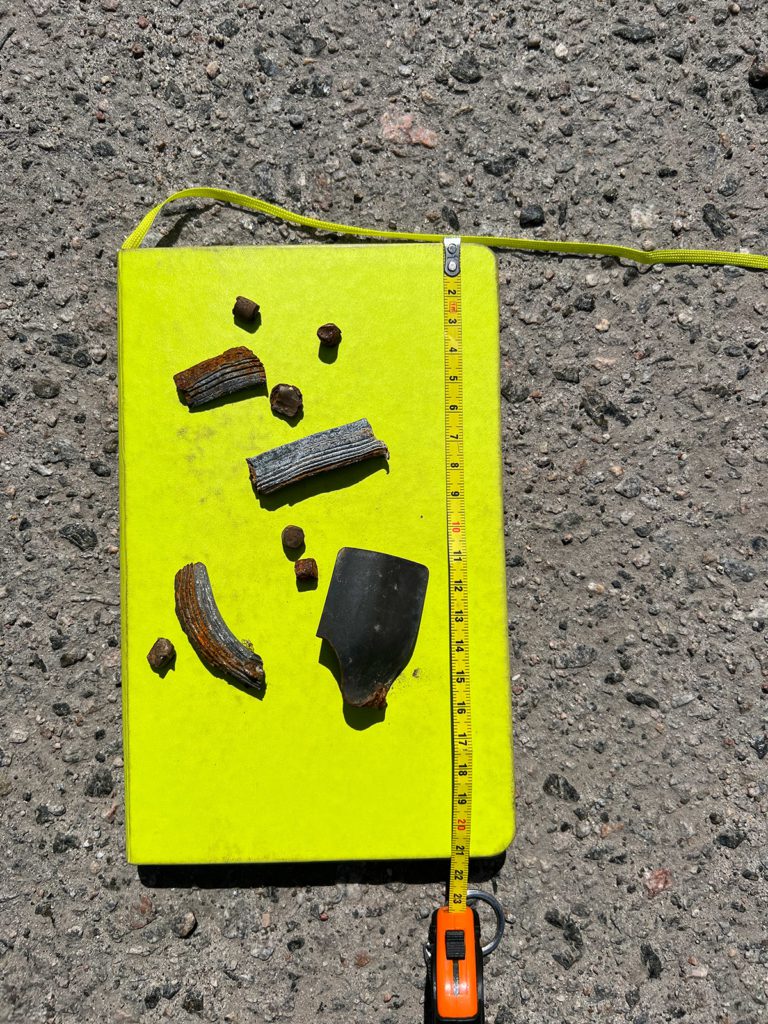
The area immediately around the church was previously shelled with different munitions on at least two occasions. On 28 February or 1 March a Grad rocket destroyed a one-storey house opposite the church where Andrii Mykolaiovych, a church worker, lived with his wife and two children.
He told Amnesty International that thankfully he had just left the house to go fetch water when the rocket struck his home. The following day another rocket struck the yard of the church, damaging vehicles parked there but causing no casualties as the volunteers involved in the church’s humanitarian work were busy inside the building.
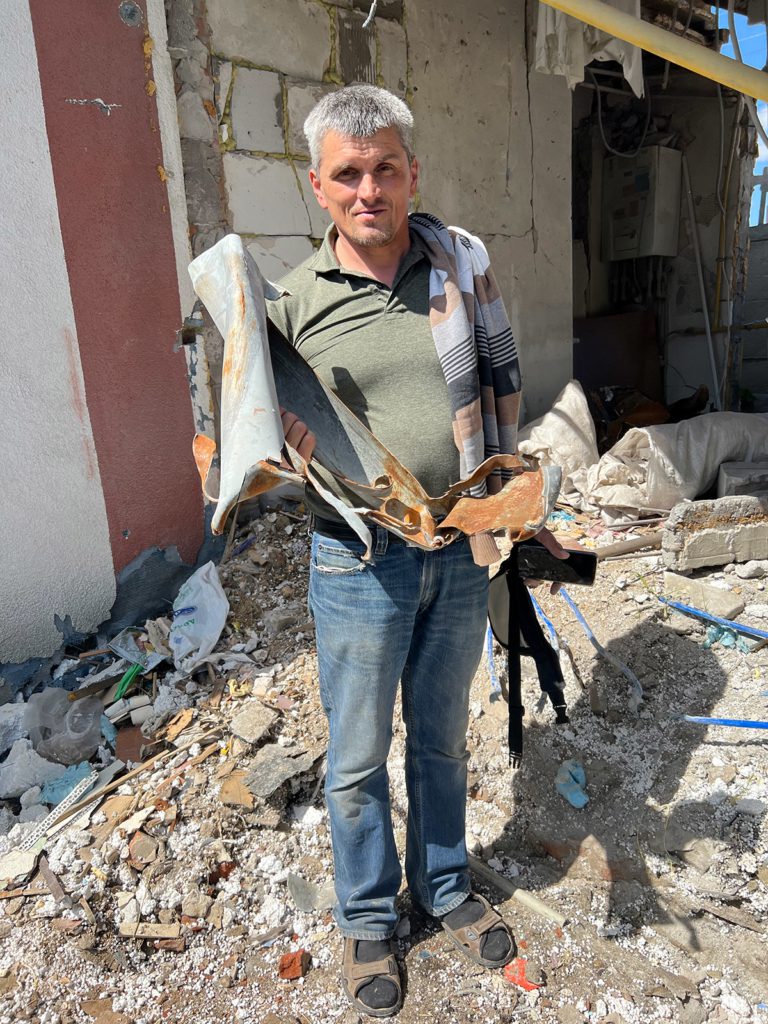
Older people killed and injured outside their homes
In Saltivka, a neighbourhood that has been relentlessly targeted since the first days of the war, two older women and a 41-year-old man were killed, and at least six of their neighbours were injured, in a series of cluster submunition explosions on the morning of 26 April 2022. Nina Nosonenko, a 50-year-old sales assistant, and her husband Valerii, age 49, were both badly injured outside their home in Haribaldi Street. Valerii told Amnesty International:
We went out at about 11:45 am and as we were by the corner of the building I heard a sound: not the usual whistle of a Grad rocket, which we had gotten used to, but a shorter, sharper sound. At the same time a shell hit the ground, exploding with a small fire and sending stones and smoke in the air. Since the explosion was at ground level I decided not to lie down and to run up the street instead. I grabbed Nina’s hand and told her to keep her head down and run. At the same time I felt a sharp pain at the back of my left thigh. I grabbed my leg with my hands and looked back and Nina was right behind me and was following me.
I was bleeding and in pain and I ran towards the first entrance of the building and asked our neighbour Olha to call an ambulance, and at that moment there was a second explosion and Nina fell to the ground. She was injured in the back. Shrapnel went through from her back to the front of her collar bone and damaged her lung.
Valerii Nonosenko
Valerii Nonosenko left the hospital three weeks after the strike while Nina was still in the hospital at the time of writing.
Other cluster submunitions exploded near the entrance of building 2 across the road, killing two older women and seriously injuring a woman and a man. The four had been sitting on the bench outside the building’s entrance. Their neighbour Liudmyla, a trauma nurse who administered first aid to one of those injured, told Amnesty International that she heard loud explosions and shrapnel went through the window of her apartment on the fourth floor and she ran downstairs.
She described what she saw as she reached the building entrance:
Tetiana Bielova and Olena were sitting on the bench by the building’s entrance with the other Tetiana and her husband when the explosions across the road happened. They got up and tried to go inside the building when another bomb exploded right here by the entrance, and they all suffered devasting injuries. I found Tetiana Bielova lying face down on the first flight of stairs inside the building. She had died on the spot.
The other Tetiana was lying face down on the steps outside the building, where she died almost immediately, and her husband was on the ground severely injured, bleeding from the head and abdomen area. He had been walking behind her; he walked slowly, supporting himself with a walking stick. Another neighbour, Olena Sorokina, was by the entrance door with catastrophic injuries; her right leg had been cut off in the blast. I applied a torniquet to stop the bleeding and her husband, who had also rushed outside, tied some fabric to her left leg to try to stop the bleeding there.
Liudmyla
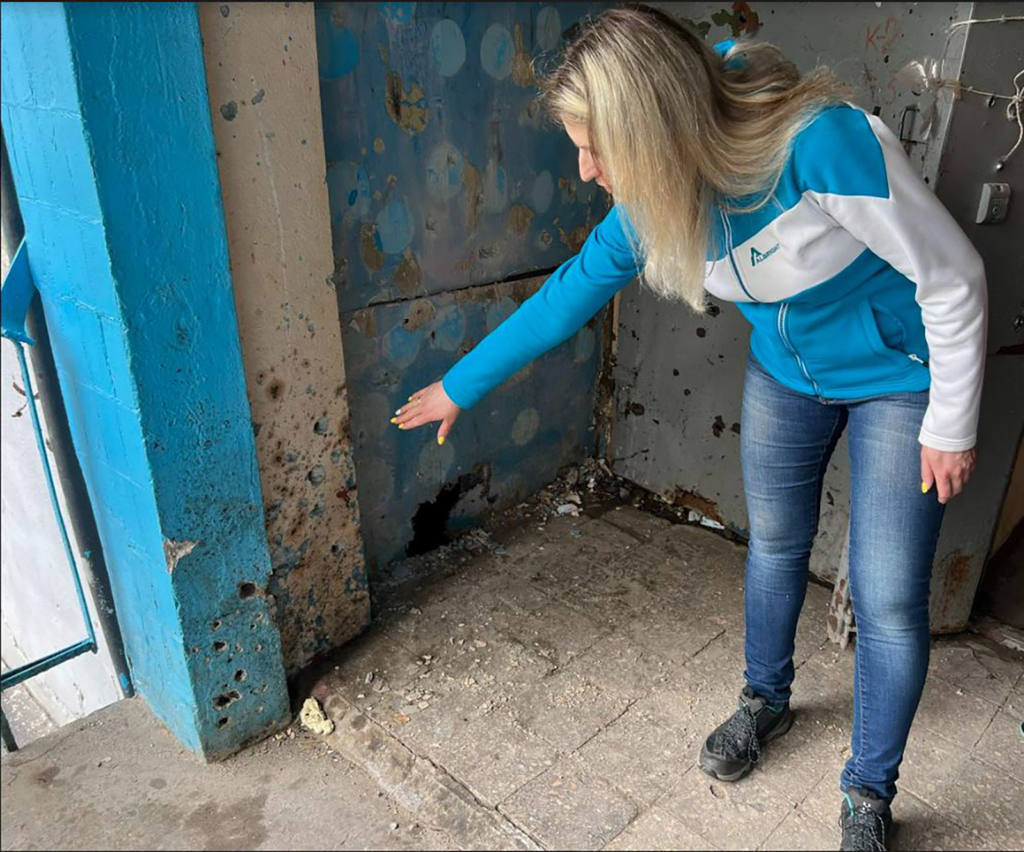
Olena Sorokina, a 57-year-old cancer survivor, lost both her legs in the blast. She told Amnesty International that she was sitting outside her building waiting for humanitarian aid delivery when she heard the sound of a flying shell and ran to the entrance of the building, where she was hit. Then she remembers being in an ambulance and realizing that she had lost a leg. She was taken to hospital, where her other leg also had to be amputated.
Olena is now in western Ukraine, hoping to be transferred to a rehabilitation facility in Europe. “After the battle with cancer, now I have to face another battle to learn to function without legs,” she lamented.
Maria Bielova, Tetiana’s daughter, told Amnesty International that shrapnel from the explosion also tore through her mother’s apartment on the ground floor of the building: “Even if mum had been inside her home she would have been hit. She stood no chance in the face of such bombing”.
A further explosion some 200 metres down the road killed Oleksandr Lebediv, age 41, who was sitting by the bus stop, and injured Yevheniia, a 42-year-old mother of two.
She told Amnesty International that she had been standing in the grocery shop where she works when shrapnel from the cluster submunition smashed the shop window and flew inside the shop, injuring her left leg.
Neighbours told Amnesty International that two passers-by, a pregnant woman and a man who were walking by the bridge further down from the shop where Yevheniia works, were also injured in the explosions.
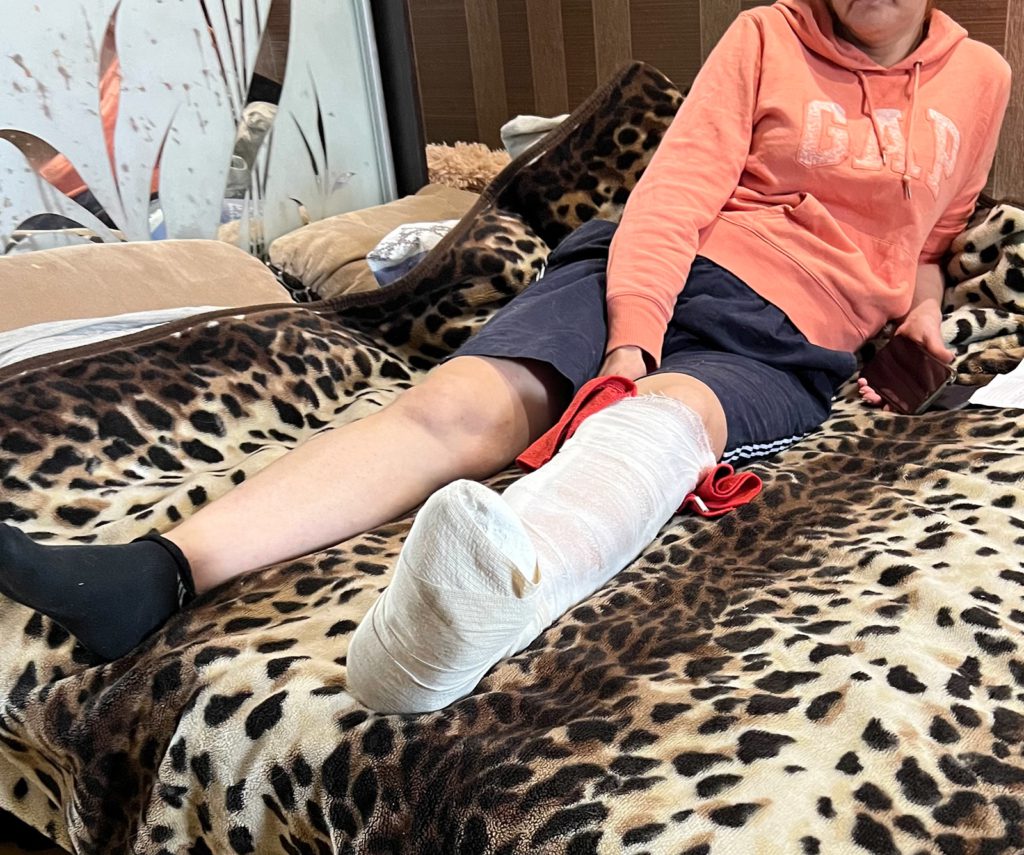
All over the area Amnesty International researchers found the distinctive fins and metal pellets and other fragments from the 9N235/9N210 cluster munitions and several craters and spalling on the ground, consistent with the damage typically caused by these cluster munitions.
All the cluster munitions strikes investigated by Amnesty International involved multiple casualties over wide areas, streets apart. Seven civilians were killed and more than 30 injured when a series of cluster munitions exploded over several streets on the north and south sides of Heroiv Stalinhrada Avenue, south of the city centre (north of the airport), in the early evening of 3 April.18 Four witnesses told Amnesty International that they saw a man and a woman killed in front of building 3 on Monyushka Street. Tetiana, a resident of the building, said:
I was in the kitchen, and when the explosion happened I felt the windows and the furniture shake and I ran to the hallway. I heard screams. Outside, a woman and a man were lying in a pool of blood by the benches in front of the building. They were both dead. A third man was taken away by ambulance. I don’t know if he was alive or dead.Pieces of the bombs came flying into our homes. My neighbour was working on the computer by the window but luckily he had decided to lie down on the sofa for a rest only minutes before the explosion. Several other passers- by were killed and many were injured in the area. It was carnage. I will never forget that day.
Tetiana
Several blocks to the southeast, on Fonvizina Street, three witnesses told Amnesty International that a man was mortally injured when a cluster munition exploded near his car outside building number 16.19 The owner of a nearby grocery store, who was himself injured by shrapnel from one of the explosions while inside his shop, said that he tried to apply an improvised tourniquet to the man’s leg to stop the bleeding, but he died within minutes. Amnesty International researchers found more than a dozen craters and fragments
of cluster munitions all over the area where residents described multiple explosions and where damage consistent with such explosions was visible on walls, fences, doors and windows. In Fonvizina Street the researchers counted six separate craters where cluster munitions exploded over a 100-metre stretch of road.
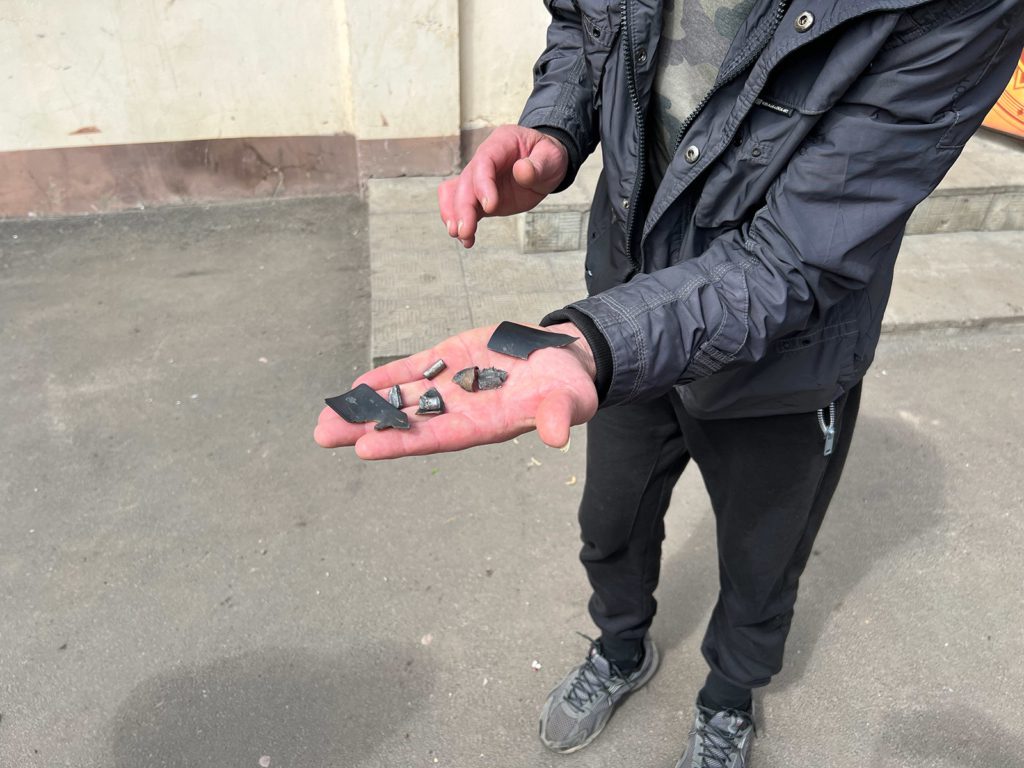
At least two men were killed in their homes and several of their relatives and neighbours injured when a series of cluster munitions exploded across several streets in the Pysochin suburb on the western edge of the city at around 5pm on 10 April.20
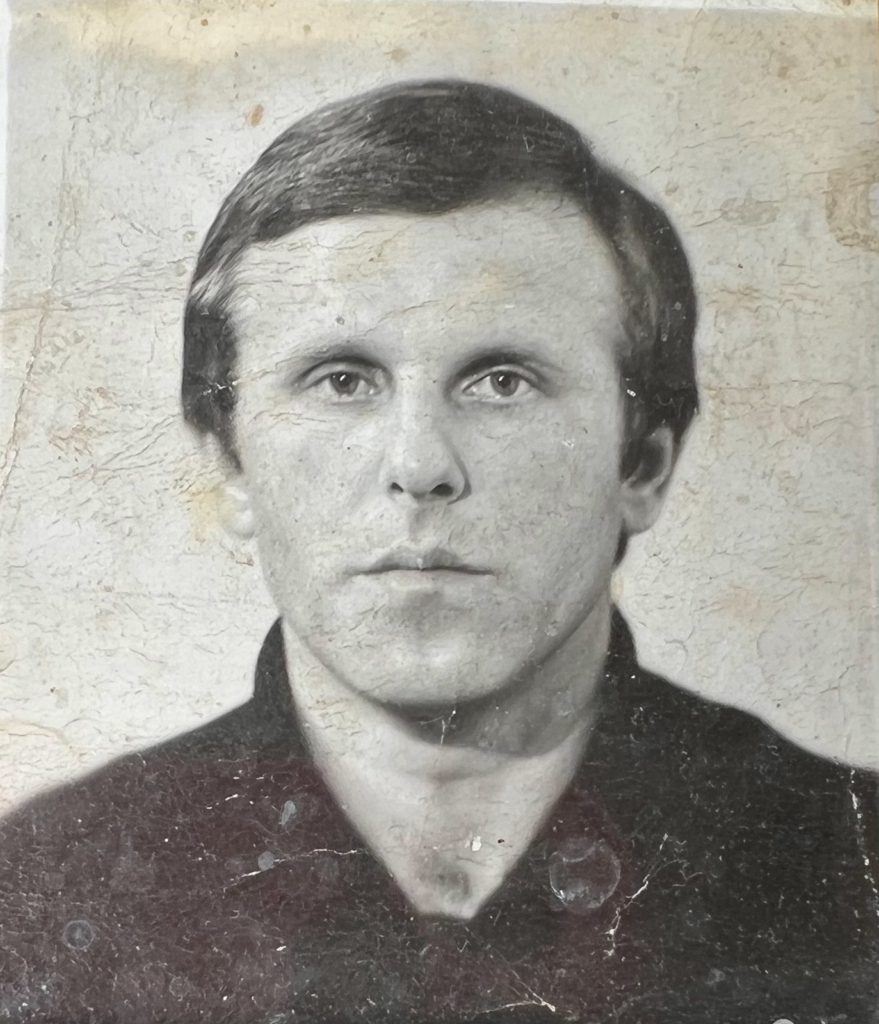
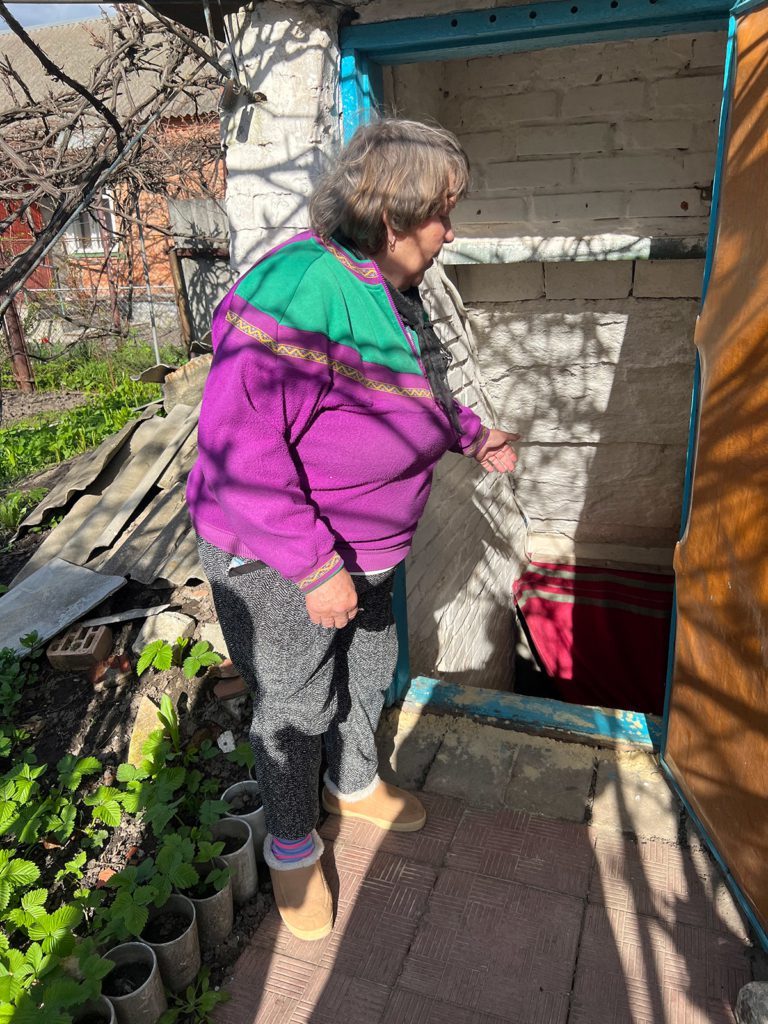
Oleksandra Andriivna, a 70-year-old pensioner, told Amnesty International that her 66-year-old brother Viktor Andriiovych was mortally wounded in the garden of their home:
I was in the garden when the explosions occurred in the area and Viktor was in the house and he ran outside and pushed me into the stairs to the cellar. I had gone down three steps when he said he was hit in his leg and he sat on the first step and blood was pouring from his leg. His main artery was cut and he quickly bled to death. I feel guilty because he came out of the house to save me and was killed. He was a fire fighter at Chernobyl when the disaster happened and then he raised his youngest son on his own. He always helped other people, and he died to save me.
Oleksandra Andriivna
In a nearby street, some 200 metres to the north-west, several other cluster munitions exploded killing Ivan Aiuvdzy, a 45-year-old salesman and father of two, and injuring his brother-in-law Yevhen Chumachenko. Both sustained shrapnel wounds to the legs. Like his neighbour Viktor, Ivan Aiuvdzy bled to death after his main artery was cut by shrapnel. Next door, his neighbour Oleksandr Lavrenko, a 62-year-old pensioner, suffered injuries to his arms as he tried to shield his head from flying shrapnel, which killed the family dog and damaged the summer kitchen - his wife told Amnesty International.
Cluster bomb attack on a graveyard
On 28 April, cluster bombs killed Valerii Zaborskyi, a 53-year-old man, in the cemetery of Kotliary, a settlement on the southern outskirts of Kharkiv, close to Kharkiv international airport. “He had just gone to the cemetery to clean the grave of his father,” said Iryna, his sister, adding that “there were a lot of people” at the cemetery, as such cemetery visits are traditional following Orthodox Easter. Valerii’s niece, Kateryna, age 39, who was there with her uncle when the cluster munitions struck, recalled that she initially saw two rockets overhead, but said that rockets flying over the village was a common sight at the time. She added:
After that we heard all the explosions around the cemetery and I heard my uncle shout: “Lie down on the ground!” We all fell on the ground and everything started to explode. There was damage … All of the shrapnel inside [the rocket] and pieces [of the rocket] fell on us in the cemetery … My sister was lying around really close to me and after the explosions finished, I checked with my relatives. I called their names: Valerii, and Ania, my sister. Ania replied but not my uncle and that’s when I realized he was dead.
Kateryna
Kateryna said that as she ran with her sister to her car, munitions continued to explode. She suffered burn wounds on her back and said two other people from her group were injured in the incident.
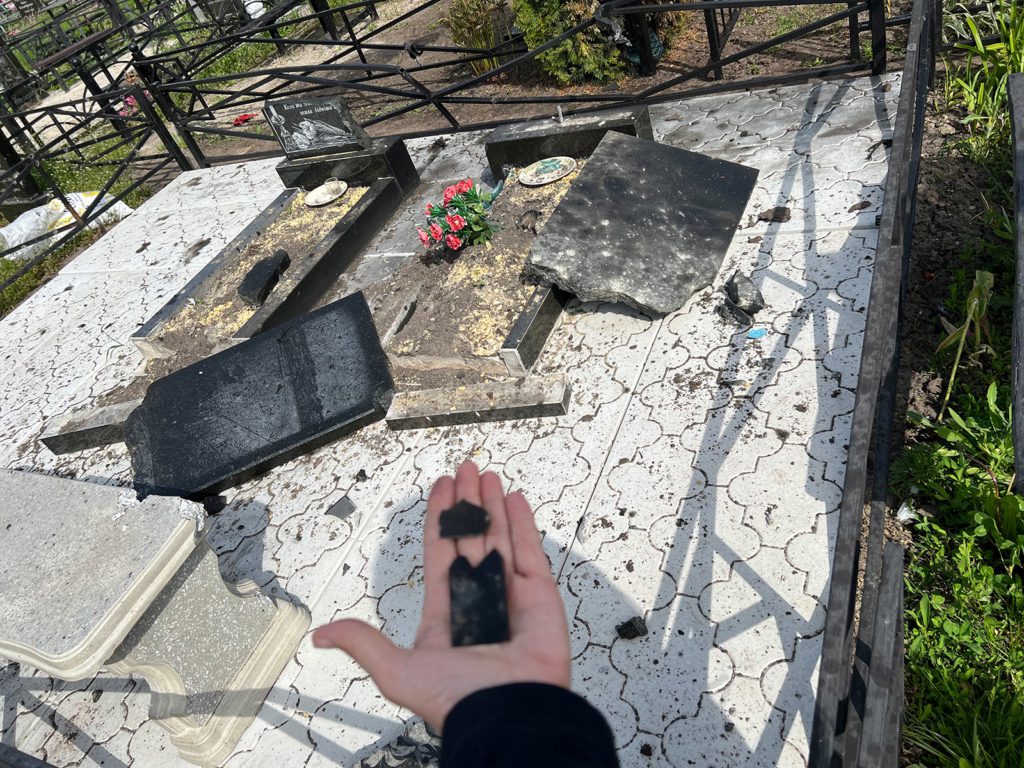
At the cemetery Amnesty International researchers found seven craters where the cluster munitions exploded, causing damage to several graves, and multiple fragments from 9N210/9N235 cluster munitions. A resident of a farm near the cemetery showed Amnesty International the spots where the Uragan rocket containing the cluster munitions landed in her field and the spot by the roadside where Svitlana, a villager, was injured.21
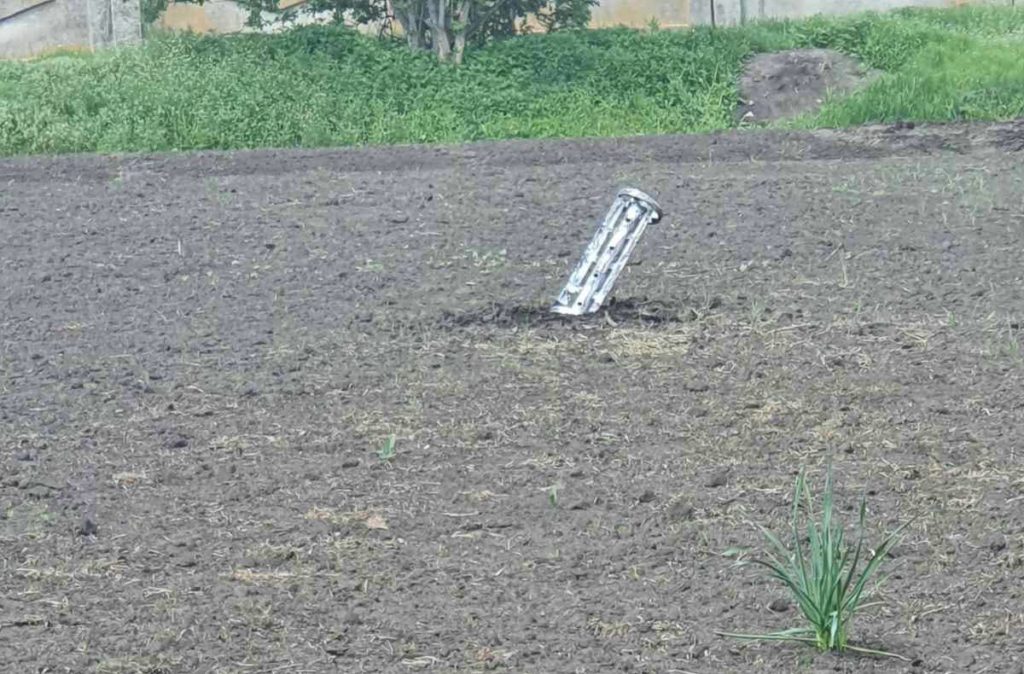
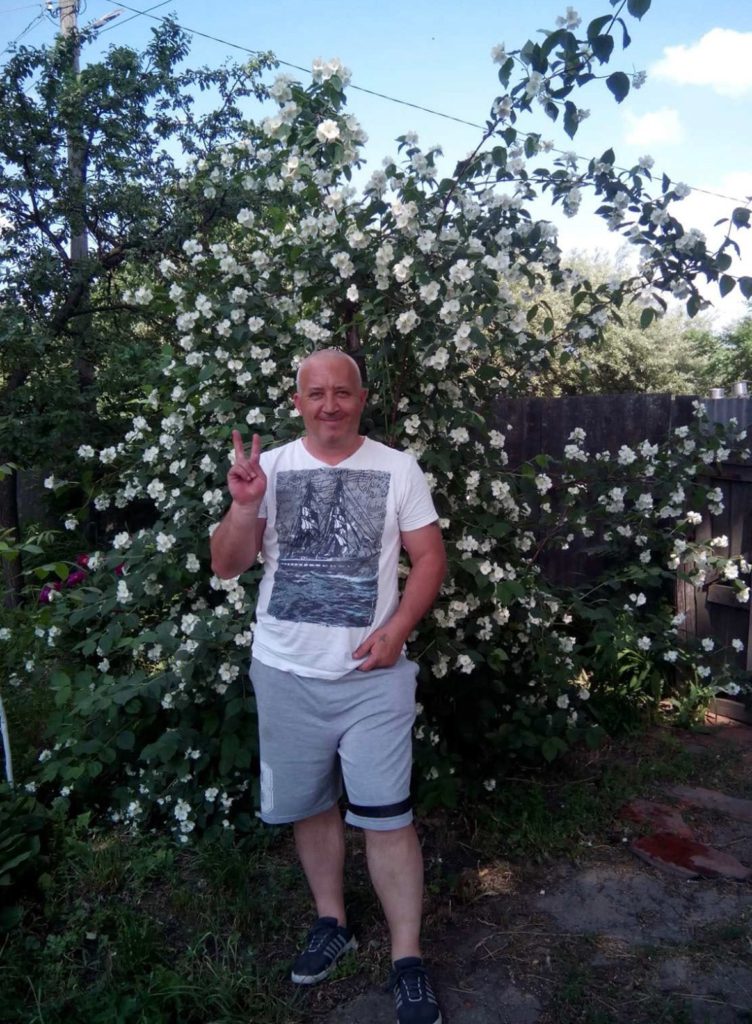
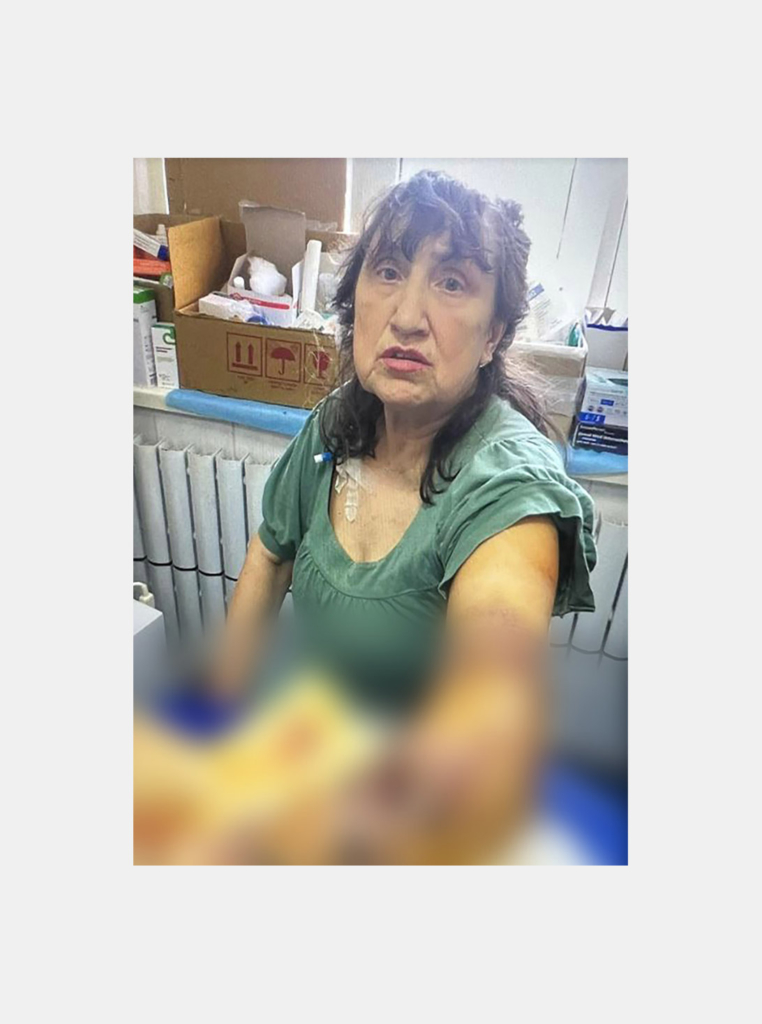
Scatterable land mines
Along Amosova Street, where more than a dozen people were killed and more than 30 injured in a series of strikes on and around eight different buildings between 13 March and 13 April, Russian forces deployed a different type of munition which combines the worst possible attributes of cluster munitions and anti-personnel land mines, both banned under international conventions.22 At least three residents of building 5 were killed in the late evening of 11 April after a rocket dispersed PTM-1SS scatterable mines around the building, setting off multiple explosions against and around it.23
Klavdiia who lives on the building’s fifth floor, told Amnesty International:
I woke up and went to the bathroom and that saved my life. Suddenly I felt the whole place shake and heard a terrible noise. The apartment above took a direct hit and my apartment got filled with smoke and dust from the crumbling walls and all the windows got smashed and the glass flew into the rooms and my front door became stuck and I could not go out until the emergency services came to help. In the apartment upstairs, a young man called Dima was killed and his two cousins were badly injured and I don’t know if they are dead or alive.
Downstairs on the ground floor a woman who had come to stay in her children’s apartment only two days earlier was killed. Her children have fled the city and she came from her apartment in the Saltivka neighbourhood, where shelling is very frequent. She came here looking for safety but found death instead.
Klavdiia
Oleh, a resident of the building, told Amnesty International that his neighbour Serhii, in his mid-forties, was killed in the ground-floor apartment that he shared with his parents, as shrapnel smashed through the window and flew into his room. These and other residents told Amnesty International that several other neighbours were killed and injured in the shelling, but they did not know their names.24
A few hours earlier, a similar strike had injured five people in the playground in front of building 13, nearby. Forty-four-year-old Olena was seriously injured when shrapnel from one of the scatterable mines tore through her legs, causing multiple fractures and lacerations to her legs, arms and back. She recounted her ordeal to Amnesty International:
I saw my friends sitting at one of the tables in the playground and I went to sit with them; there was Oleksandr, Volodymir and a young couple who had come to say hello to Volodymir. I heard a whizzing sound and the friend who sat opposite me looked up and stood up and ran. I followed him but as we were running a rocket/shell flew past over our head and exploded ahead of us and we fell and then another one exploded behind and injured me. I felt a sharp pain and heard another explosion further back.
At the hospital they took out lots of shrapnel from my body. My leg is broken and my calf is mostly missing and I have cuts and lacerations and need skin grafts.
My friends were badly wounded. Oleksandr suffered a bad head injury and was in the neurosurgery ICU for a long time and Volodymyr lost part of his foot and had shrapnel injuries to his back. The other young man was in a serious condition and went into a coma and I don’t know if he survived. All I can say is that I’m grateful to be alive.
Olena
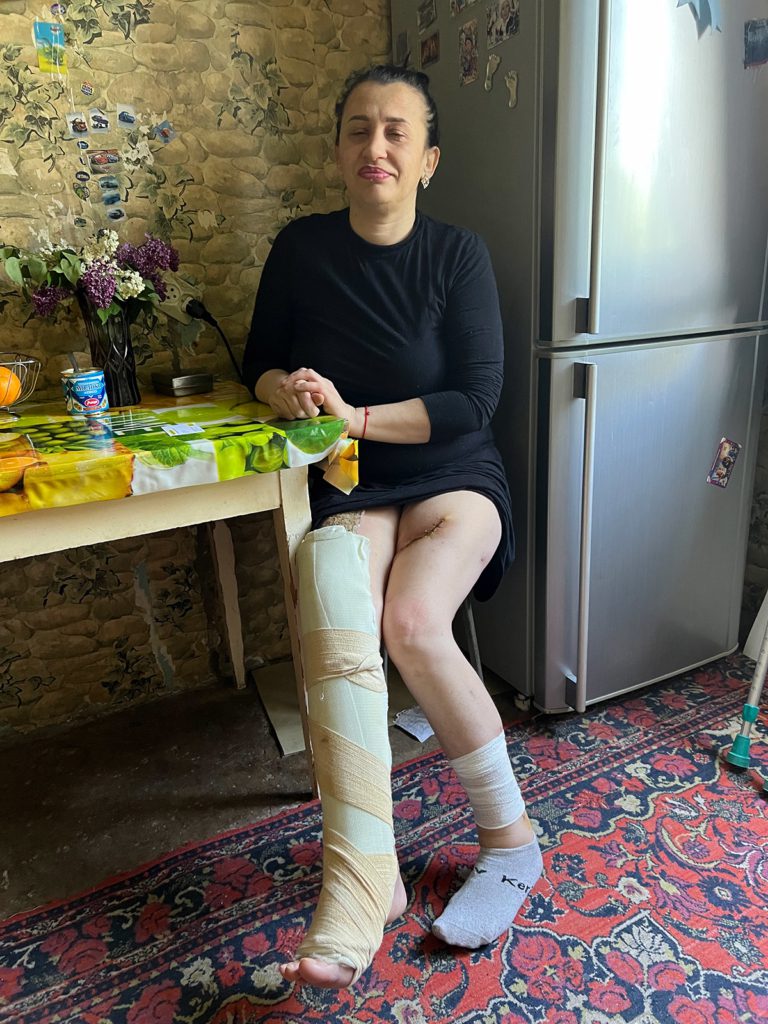
The same type of munition was previously used on 3 April in Bezruky, a village north-west of Kharkiv.25
Cluster munitions and scatterable mines
Amnesty International researchers documented seven strikes in different areas of Kharkiv, where they found fins and pellets of 9N210 or 9N235 cluster munitions and fragments of 220mm Uragan rockets.26 Each rocket rockets contains 30 individual munitions that have a “frag sleeve” consisting of pellets made from chopped steel rods.27 At each location the researchers also found multiple impacts, including distinctive spalling on the ground, consistent with the expected damage from 9N210/9N235 cluster munitions. Doctors at two hospitals in Kharkiv showed Amnesty International researchers the distinctive pellets which they had removed from patients injured in cluster bomb strikes.
Cluster bombs are inherently indiscriminate. Rockets release dozens of submunitions in mid-air, scattering them indiscriminately over a large area measuring hundreds of square metres. In addition, cluster munitions have a high dud rate, with a high percentage failing to explode on impact and thus effectively becoming land mines, which pose a threat to civilians long after deployment. For these reasons the use (as well as production, stockpiling, and sale or transfer) of cluster munitions is prohibited under the 2008 Convention on Cluster Munitions (CCM), which 110 countries have joined.
Even though neither Russia nor Ukraine are parties to the CCM, they are obliged to respect the ban on the use of inherently indiscriminate weapons that forms part of customary international humanitarian law.28
Russian forces have also used another type of munition against residential neighbourhoods in Kharkiv, one that combines the worst attributes of cluster munitions and of anti-personnel land mines: the PTM-1S, a small, scatterable anti-personnel mine. Scatterable mines such as these, which can be activated by individual people, are banned under the 1997 Convention on the Prohibition of the Use, Stockpiling, Production and Transfer of Anti-Personnel Mines and on their Destruction.29
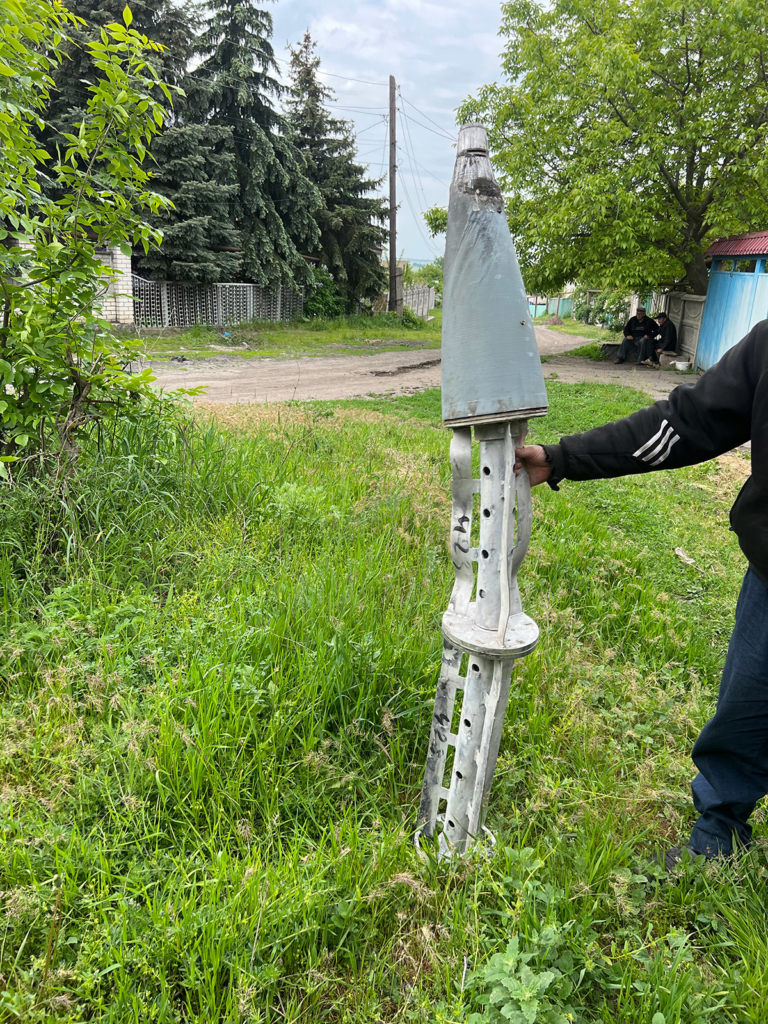
Other strikes
Beginning in the first days of the invasion at the end of February, Russian forces launched indiscriminate strikes on residential neighbourhoods of Kharkiv, forcibly displacing more than half the city’s population by late May.30 The relentless barrage of unguided rockets and artillery shells – which are inherently inaccurate, have wide area effects and should never be used in populated urban areas – killed hundreds of civilians and maimed hundreds more.31 They caused wholesale damage and destruction, leaving scores of large multi-storey buildings uninhabitable, each containing hundreds of apartments.
Unguided rockets, such as Grads and Uragans, which have been routinely used by Russian forces to shell residential neighbourhoods of Kharkiv, are inherently inaccurate and produce wide area-effects, making them indiscriminate when used in populated areas.32 Likewise, standard artillery rounds without precision guidance kits have a typical circular error probable (meaning the radius of a circle within which one would expect only half the rounds to fall) of over 100m. In residential areas where buildings are no more than few metres apart, such inaccuracies are virtually certain to cost civilian lives and cause extensive destruction and damage to homes and other civilian objects.
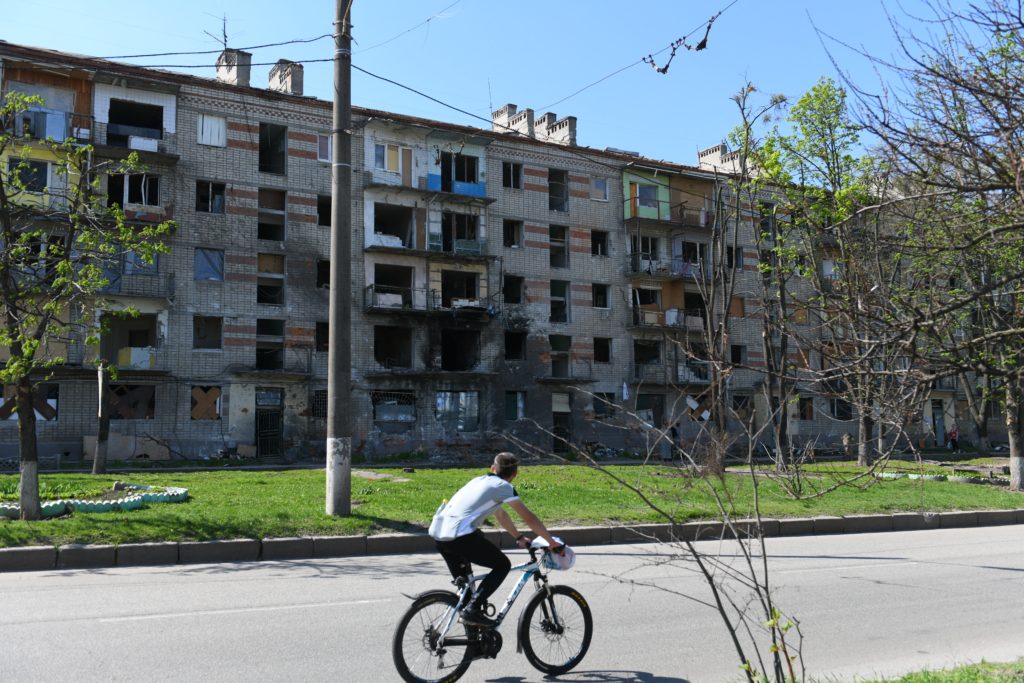
In multiple neighbourhoods across the city, civilians killed and maimed
At least seven civilians were killed and dozens more injured by multiple strikes launched by Russian forces in the early afternoon of 1 March on Nova Bavariya Avenue, in Kharkiv’s Novobavarskyi District. A rocket or artillery shell struck the pavement in front of building 95, and a larger bomb or missile struck a crane factory opposite the building, on the other side of the road. Several of the victims lived in building 95 and the building just behind it, building 97.
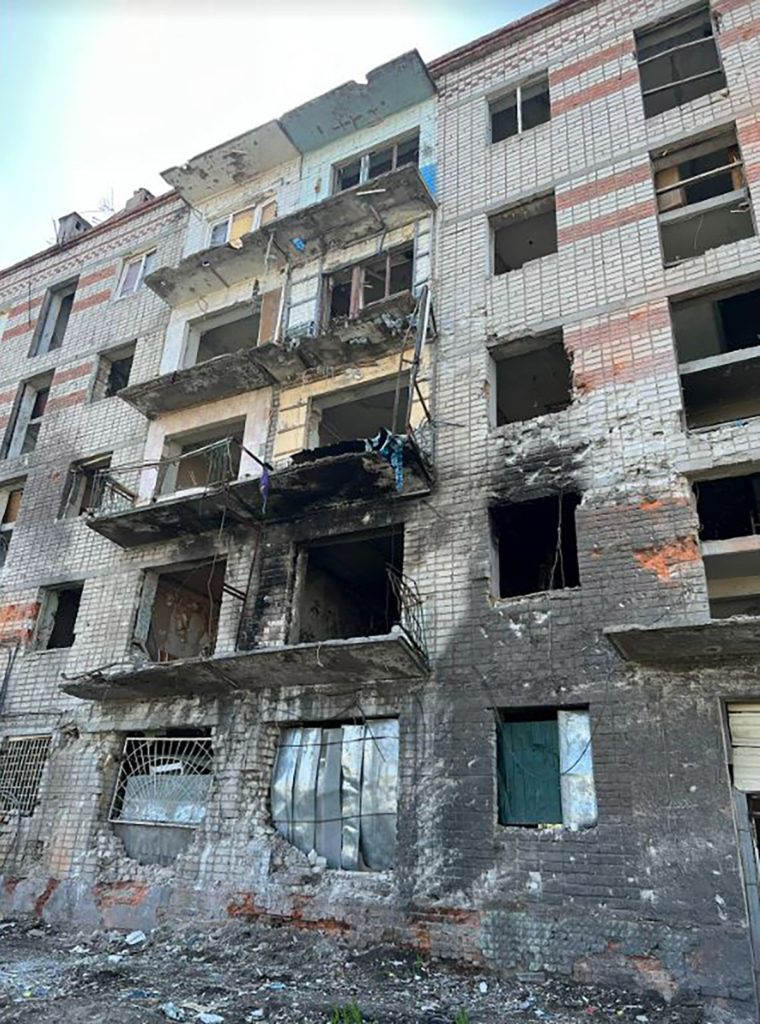
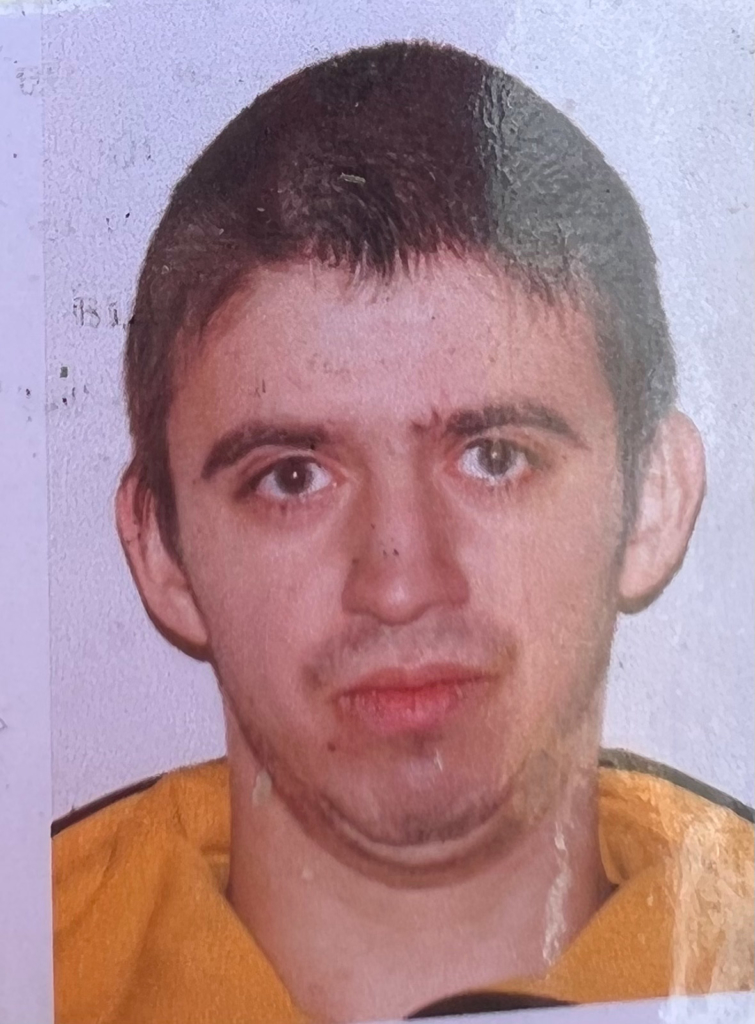
Kostiantyn Neshcheret told Amnesty International that his mother Zoia, age 69, and his brother Danylo, age 24, died in the strike in front of building 95, along with his friend Andrii Chycholik, age 48. He recalled:
My mother and my brother were sweeping the pavement outside the building. It was all quiet and the strike was completely unexpected. I was with them until shortly before the strike, but I had gone to buy some food for lunch at the store at the back of the building and while I was there the strike happened. That is why I am alive.They were killed on the spot by the blast, along with my school friend Andrii Chycholik, who was killed by a tree 25 metres away. It was a huge bombardment. I was thrown to the ground by the force of the blast, even though I was behind the building.
Kostiantyn Neshcheret
Other residents told Amnesty International about four other neighbours who were killed in the blast – Iryna Lisovska was killed in her apartment directly above the strike on the pavement of building 95; 70-year-old Yurii Shesterov, who was killed in his apartment opposite the factory; Roma Demianenko, age about 65, who lived in building 95; and Stanislav Bacanov, in his 30s, who lived on the first floor of building 97. “I had seen him 10 minutes earlier at the market,” one resident said of Roma Demianenko. “When the bomb hit he was standing right in front of the building, and he was blown to pieces.”
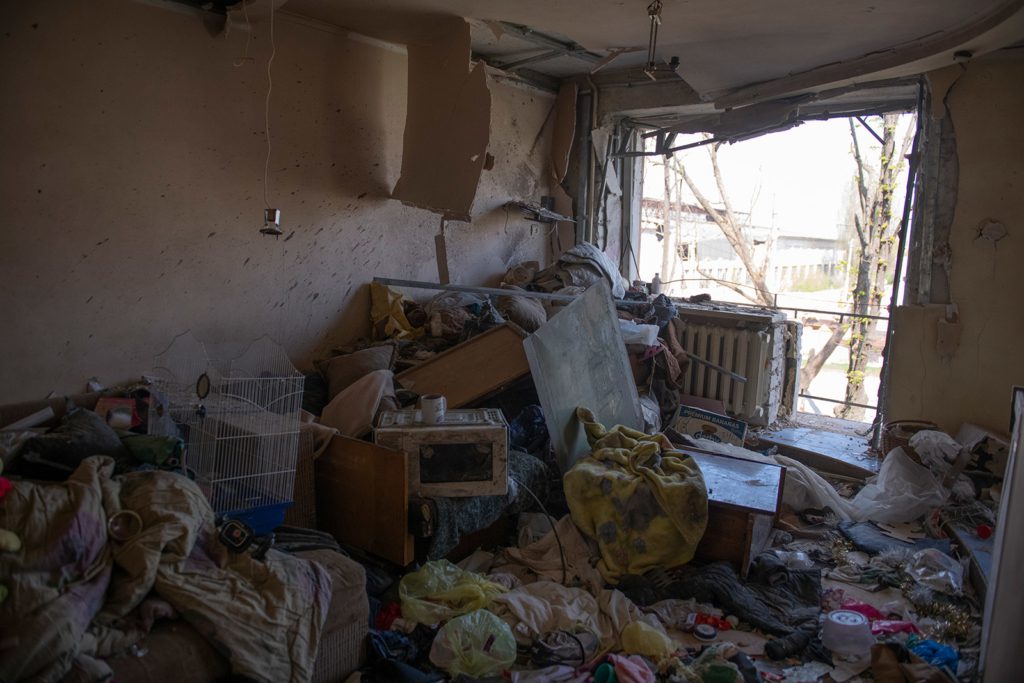
Doctors at the nearby Municipal Hospital Number 3 told Amnesty International that they received 70 patients who were wounded in the blast, 20 of whom suffered severe injuries and 50 with moderate to light injuries. Doctors and local residents said that many of the wounded had been standing in line to receive humanitarian aid at a distribution point on the road.
Viktor Kovalenko, a 72-year-old man who lived opposite the factory with his wife, showed Amnesty International their apartment, destroyed in the blast. They are now staying with their daughter, having lost their home and most of their possessions.
“Living here is like Russian roulette,” a resident of building 97 told Amnesty International. “You don’t know any day whether you’ll live or die.”
The same sentiment was echoed by 59-year-old Tetiana Oleksandrivna, who sustained multiple fractures and lacerations to her leg when she was trying to go from the basement to her apartment in building 112, at the eastern end of Myru Street in the early afternoon of 13 March. She told Amnesty International from her hospital bed.
We were sheltering in the basement and I only went out for a minute to go upstairs to my apartment. The strike happened just at that moment and I was injured. My neighbour, Stas Chikin, was killed. He was in the basement with his wife and his six-year-old son and his parents. He just went out for a moment to smoke a cigarette and was killed in the strike. Anyone can die at any time. Tetiana Oleksandrivna
Other neighbours at the building told Amnesty International that another resident, Volodymyr Lisnenko, aged about 60, was killed while sweeping the floor in the hall of entrance 4 of the next building (number 114).
Such strikes often involve multiple rockets or shells landing scores or even hundreds of metres apart, each sending deadly fragments flying all around.
Oleksandr Marchenko, a 27-year-old electrician, who was injured when a volley of Grad rockets struck a housing complex off Heroiv Pratsi Street, north-east of the city centre, at around midday on 23 April, told Amnesty International: “I was on my way back home from the pharmacy when I heard explosions around me. I ran to hide in the nearest building (12D) but just as I got close to the entrance I was hit.” He sustained serious injuries as shrapnel penetrated deep into his abdomen and back, embedding in his lungs and liver.
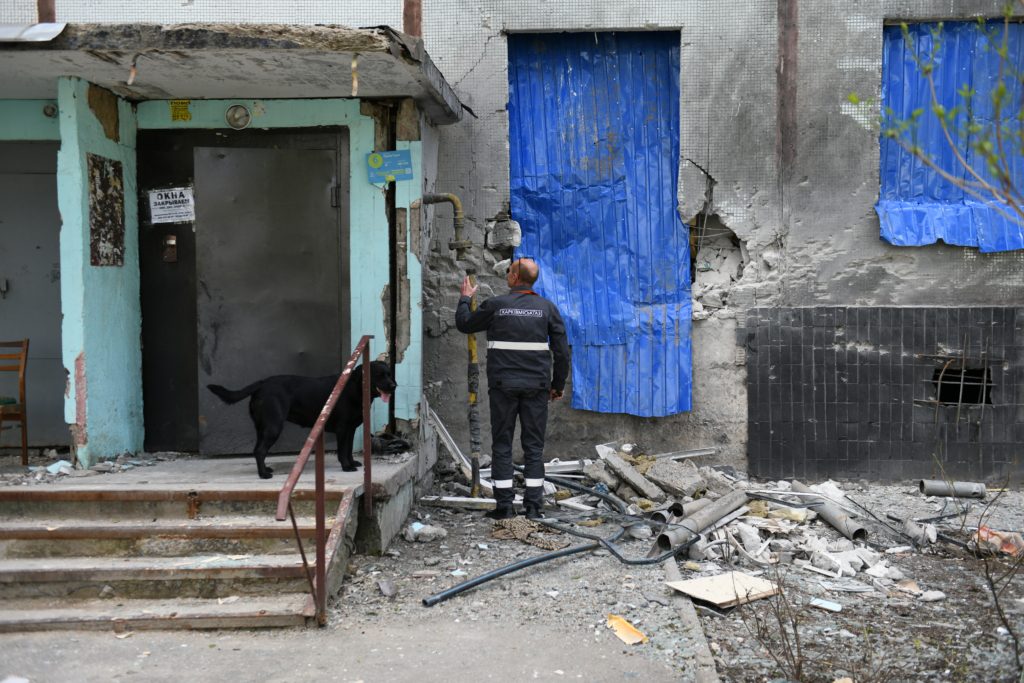
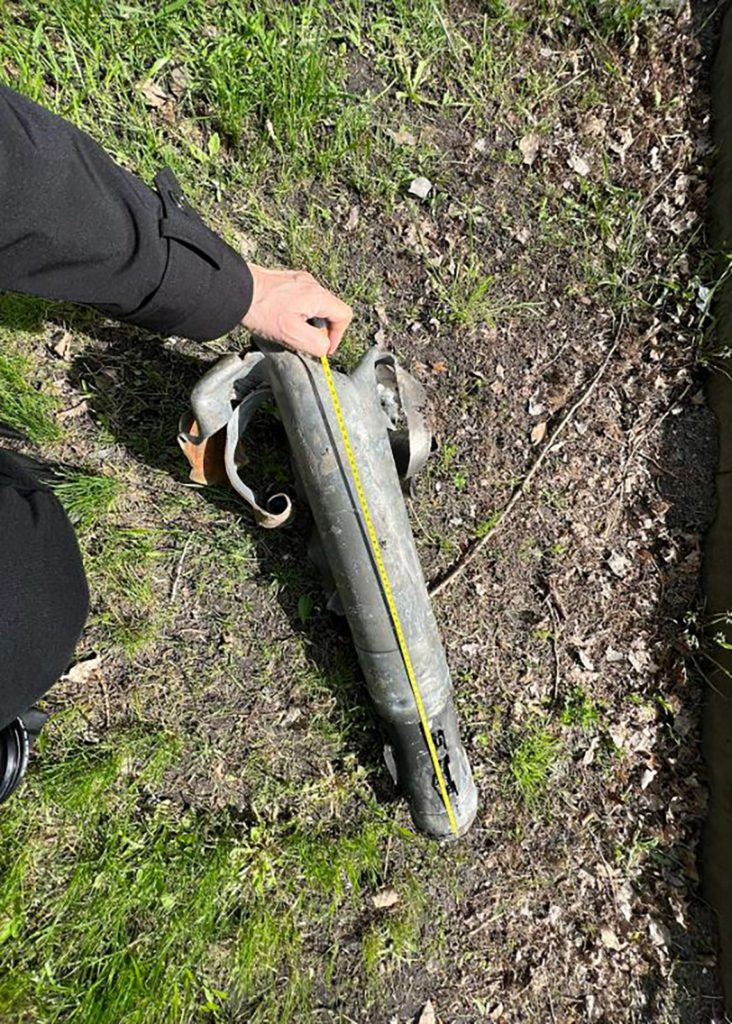
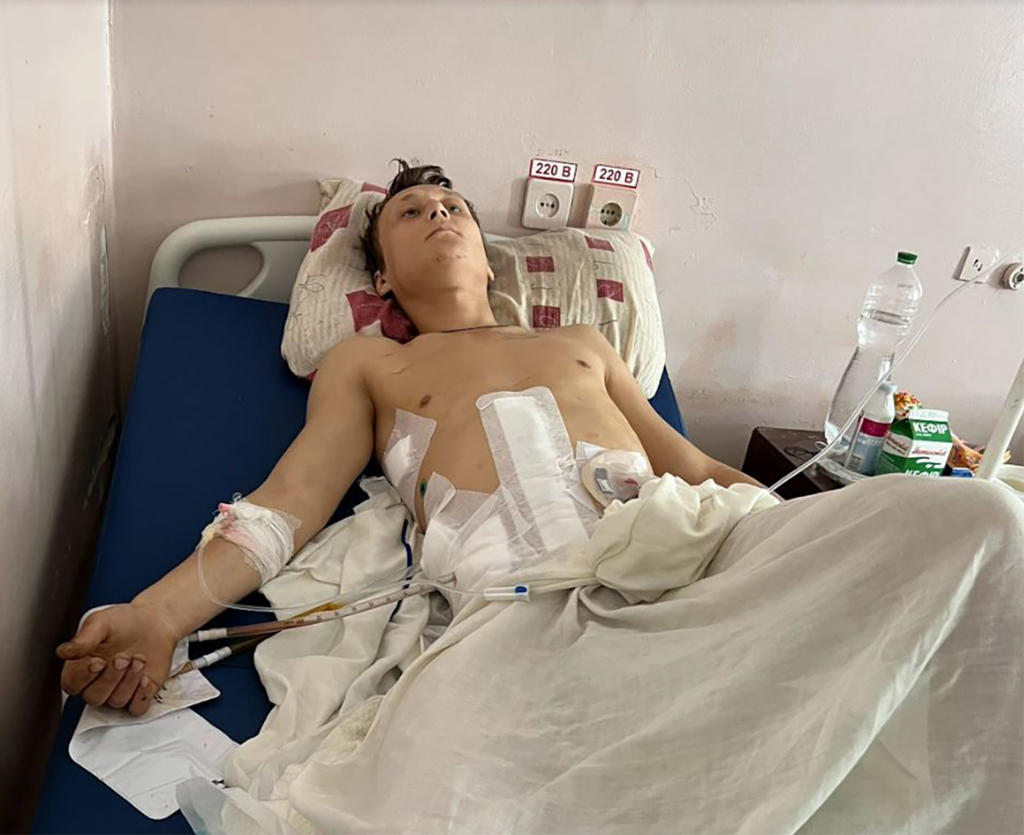
At the site, Amnesty International researchers identified 12 separate craters with remains of Grad rockets within an area less than 30 acres (0.12 square km) between the buildings surrounding the spot where Oleksandr Marchenko was injured. Three other residents told Amnesty International that several people were killed and injured in the multi-rocket strike.33 Scores of apartments in several residential building as well as a school were damaged.
Limbs lost as a result of rocket and artillery strikes
Veronika Cherevychko, a 30-year-old logistics manager and mother of a nine-year-old boy, lost her right leg when a Grad rocket struck a playground in front of her home in the Saltivka neighbourhood in the afternoon of 12 March, killing and injuring several people. She told Amnesty International:
I was sitting on this bench when the explosion happened. I remember hearing a whistling sound just before the explosion. Then I woke up in hospital, without a leg; my right leg was gone.
Now my life is divided into before 12 March and after 12 March. I will get used to this. Now I am not yet used to it; I often try to touch my leg, to scratch my foot: the leg and the foot that I am missing.
I don’t know what to say about people who did it. I will never understand them.I heard that other people were killed in the strike but I don’t know who they are. I was unconscious.
Olha Maltseva, age 63, was struck by a fragment of a Smerch rocket outside a grocery store near her home in Klochkivska Street, north-west of the city centre, on 28 February.34 She told Amnesty International that she had been standing in line with lots of people outside some shops when the rocket landed by the door of the shop:
Olha Maltseva
There were three lines of people outside the three shops, so a lot of people. As the rocket approached people ran away but I could not move. I was paralysed by fear. Maybe I was in shock. All I know is that I could not move. My left leg was cut off on the spot by the rocket and my right leg was badly injured and will require months more of treatment.
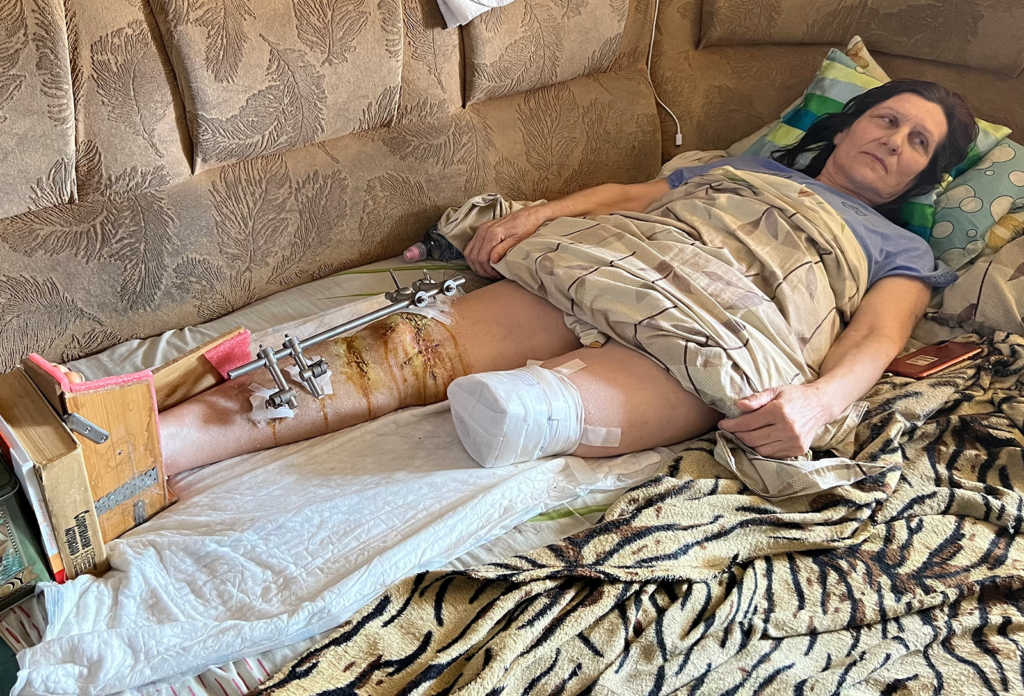
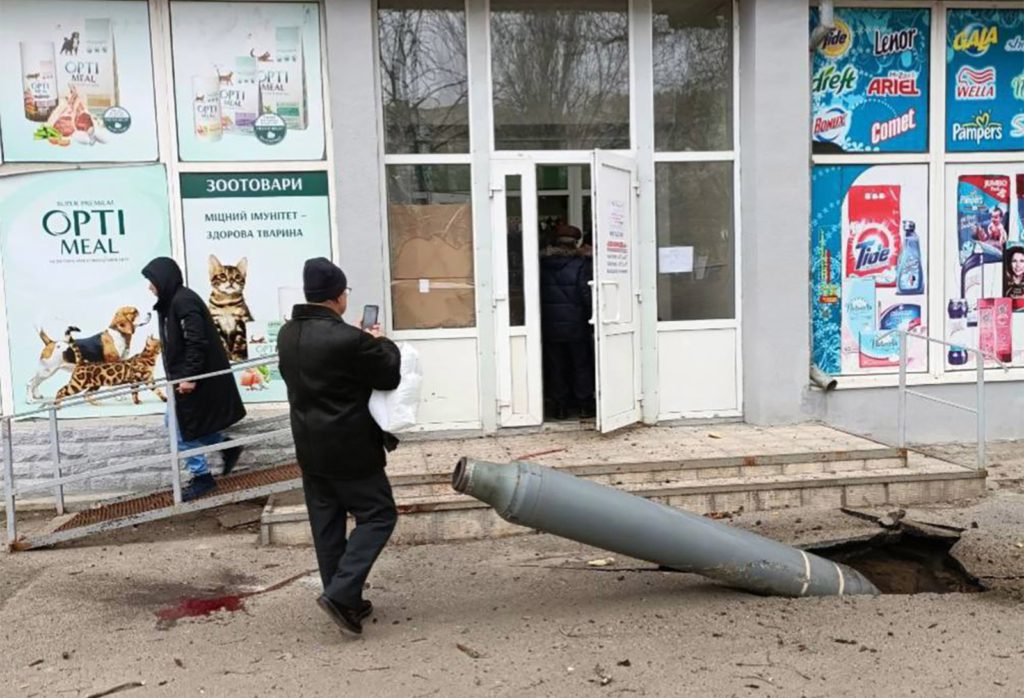
On Amosova Street, where different buildings and their surroundings came under shelling repeatedly, Yurii Chekhonin, a 61-year-old pensioner, lost both his feet when a rocket struck the fifth floor apartment above his and went through the floor and into his living room at 4am on 30 April. He told Amnesty International that he saw sparkles as the rocket smashed through the ceiling of the living room where he was lying on the sofa. The rocket cut off both his feet and set the apartment on fire. His wife recounted the horror of having to drag her catastrophically injured husband out of the burning room as the fire spread through her home.
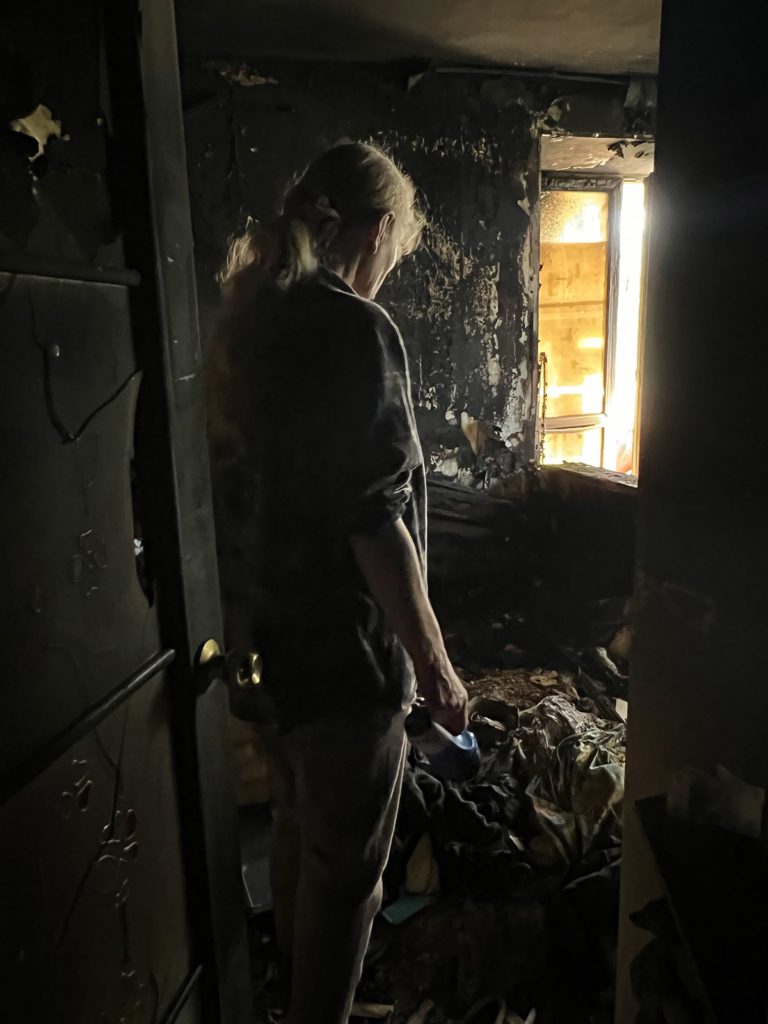

Shelling on Buchmy Street, Saltivka District
Shelling on or near three buildings on Buchmy Street, in the hard-hit Saltivka District, killed at least eight civilians and injured at least four.
Rockets killed 40-year-old Konstiantyn Lymar and his partner Hanna Lakhno, age 33, and their friend Andrii Ihasimov, age about 40, in the early afternoon of 3 March, in front of building 44B, where the couple lived. “Konstiantyn and Hanna were planning to flee the city. Konstiantyn wanted to send Anna to his father in the Odesa region, a safer place,” said their friend Yefim, who was with them in the hour before their death. The couple “had a backpack with their passports, their Ukrainian IDs, and even a passport for the dog,” recalled Hanna Lakhno’s brother.
The shelling tore Konstiantyn Lymar’s body apart and inflicted catastrophic injuries on Hanna Lakhno and Andrii Ihasimov. The three bodies stayed on the street for several days, covered in snow, said Yefim. Their devastating injuries made identification difficult.
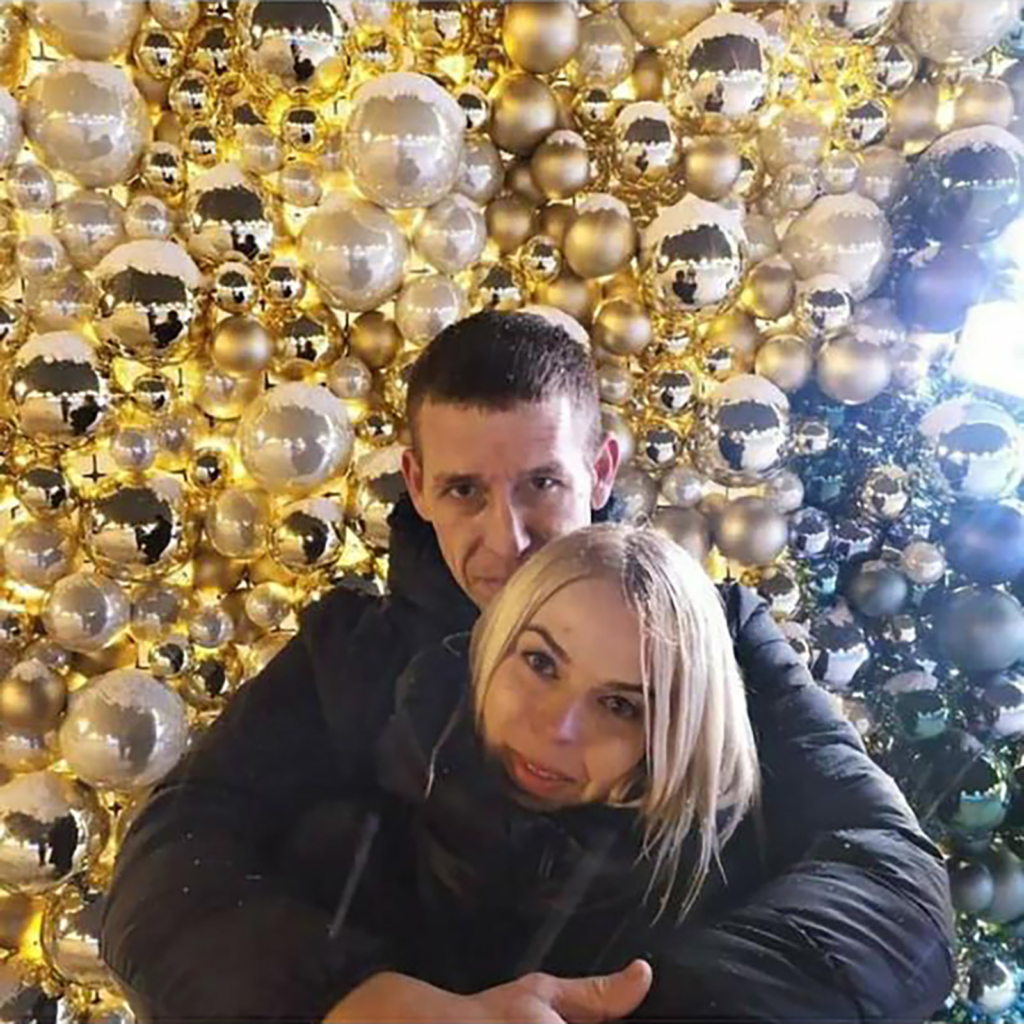

Further down the road, building 40a on Buchmy Street, which Amnesty International delegates visited, was hit by shelling on 27 February. The incident killed one and injured two, according to the regional fire department. Building 36, which lies directly next to it, was first hit directly on 3 March.
Serhii Yakovliev, a 62-year-old resident of the area, was severely injured when the high-rise building in which he lived was hit by shelling on 3 March at around 1:30pm. He recalled:
My flat is on the 2nd floor … It was around 1.30 pm … I was in my kitchen having a meal. When I was done, I heard one hit … The second shell arrived in my apartment, entered the kitchen and destroyed my gas stove. There were three shells that entered my flat and didn’t explode but flew through the room. I tried to hide in the corridor. There was some bright fire but I didn’t hear an explosion. I got knocked out by the blast. People from … the emergency services came to my apartment, pulled me into a room, and put a bandage on my arm to stop the bleeding.
Serhii Yakovliev
Serhii Yakovliev’s left arm was smashed in the incident and later amputated; he also lost his right-hand thumb, which was cut by shrapnel.
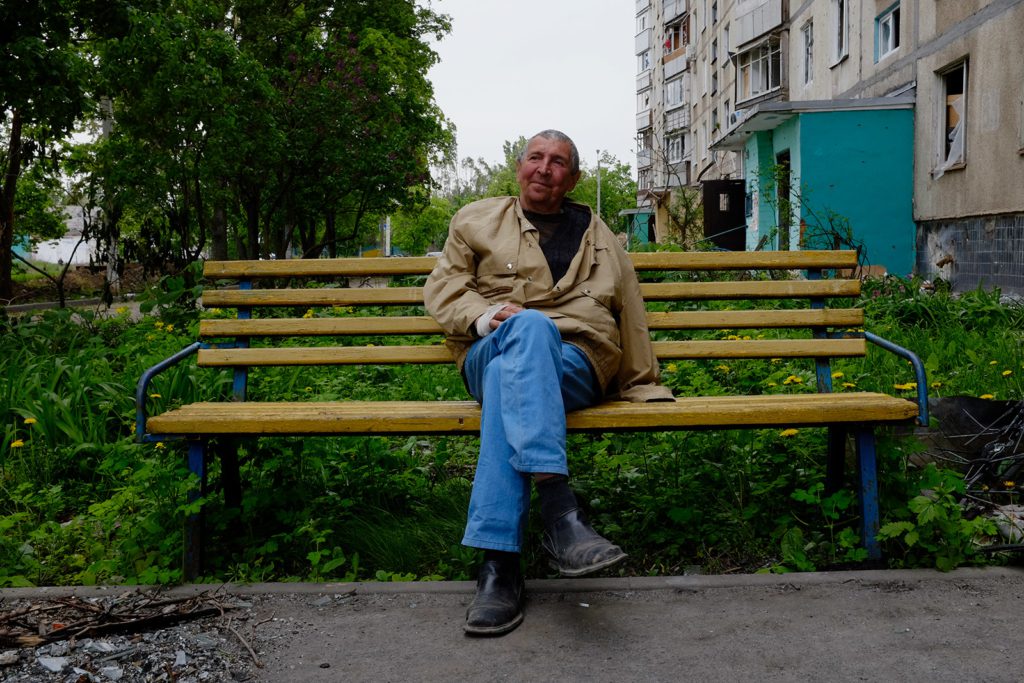
Serhii Shyp, a resident of Buchmy street in Saltivka, said that he witnessed the killing of four civilians near building 36 during the first month of fighting. Showing the site where the shells landed, he told Amnesty International:
"At the end of the building, there is a kiosk for water supply. At the time of shelling, I met [there] a guy who was covered in blood … He was wounded … I asked if he needed help and he said no, but that his wife did. She was lying by the kiosk and she was dead. I actually saw multiple corpses … The woman by the kiosk had a huge wound in her stomach area … There were three more bodies, one of them was an old man. The two others, I didn’t go close enough to see … The emergency team were trying to help people who were still alive, [so] they went to another building …
The bodies lay there for a full day. It happened during the first month [of fighting] … I don’t know the date. We were all sleep deprived."35
At the end of the building, there is a kiosk for water supply. At the time of shelling, I met [there] a guy who was covered in blood … He was wounded … I asked if he needed help and he said no, but that his wife did. She was lying by the kiosk and she was dead. I actually saw multiple corpses … The woman by the kiosk had a huge wound in her stomach area … There were three more bodies, one of them was an old man. The two others, I didn’t go close enough to see … The emergency team were trying to help people who were still alive, [so] they went to another building …
The bodies lay there for a full day. It happened during the first month [of fighting] … I don’t know the date. We were all sleep deprived.35
Serhii Shyp
Shelling elsewhere in Saltivka
On 19 April shelling killed Yurii, a man in his 60s, in front of Building 66 on Heroiv Pratsi street, in Saltivka. Yurii was there to take care of his sister’s flat. “He was coming back from the store. I sat on the bench [in front of the entrance] with my neighbor Nina when he approached the building and asked for a cigarette,” said Serhii Andrushechko, one of three witnesses to Yurii’s death interviewed by Amnesty International.
There was a huge explosion. A shell fell in front of the building, approximately 22 meters from the entrance. Shrapnel hit Yurii in the buttocks. Yurii fell. Nina opened the door and asked me to pull Yurii inside. He was unconscious. The neighbor called the emergency services to take care of him. It was a chaotic atmosphere. When they came they saw more bleeding. Yurii subsequently died of his injuries.
Serhii Andrushechko
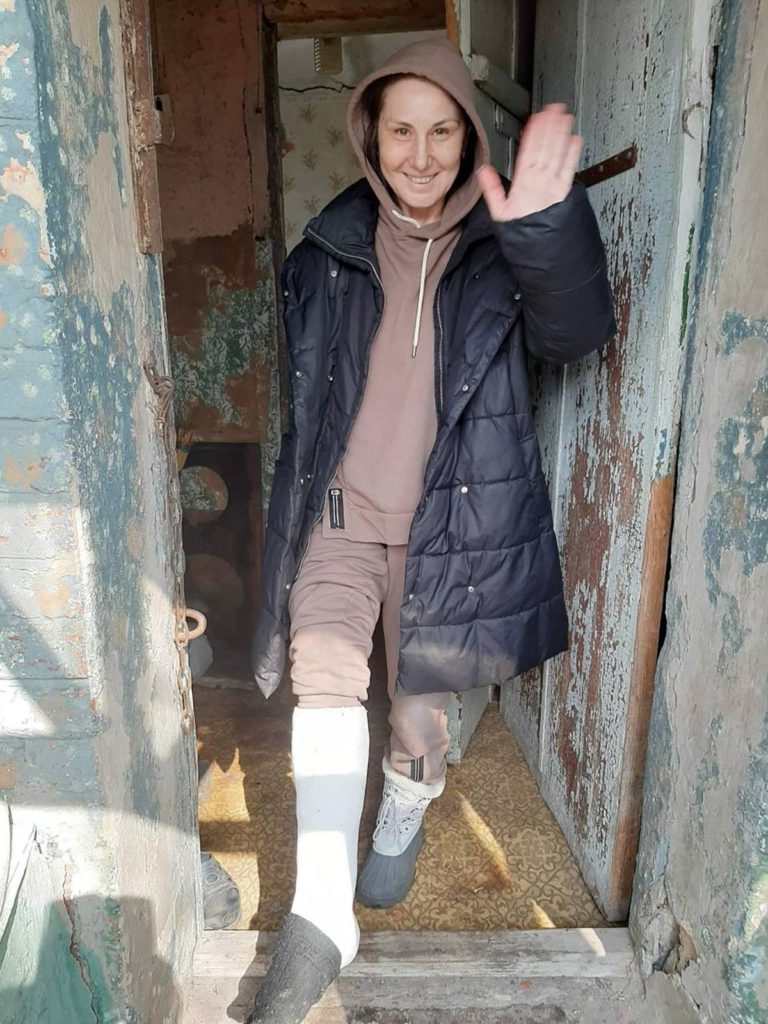
On 12 April, at around 2:15 pm, a rocket strike injured Viacheslav “Slavik” Rubizhanskyi and his neighbor Svitlana Reshetova on Poznanska street, in Saltivka. “It was basically a calm day, we didn’t expect any escalation,” recalled Svitlana Reshetova, whose apartment is on the ground floor. She continued:
There was an air raid alert … We started to be nervous at first but then relaxed after a couple of minutes. After that I moved to the living room and we put tape in front of all of the windows and we covered them halfway with wood paneling. And we sat on the couch which was further away from the windows. It was completely calm outside, no signs, no sounds, we were chatting and then we heard a huge explosion just a couple of metres out of the window. We started to look outside but it in an instant the window broke. We saw a fire, a blast, dust coming into the air.
Svitlana Reshetova
Svitlana Reshetova sought to escape her apartment with her husband and mother, but was injured in the heel. She recalled:
When we were passing through the door, I got injured. I didn’t realize at the moment if it was a blast or shrapnel but I started to scream to my husband: “I cannot move anymore!” My husband tried to pull me to the basement while I was trying to make the effort to step on my wounded leg, but I barely could.
Svitlana Reshetova
In the building, she said, “everyone was screaming.” Residents found refuge in the basement.
Svitlana Reshetova’s neighbor Viacheslav Rubizhanskyi, who lived in another ground floor apartment on the side of the building that was exposed to the blast, was also injured. “My finger was cut off by shrapnel,” he said, showing his bandage.
Amnesty International delegates examined the site of the blast and found a crater with remains of a grad rocket a few metres way from Rubizhanskyi’s window.
Strikes on single-family homes
Serhii Tkachov, a 67-year-old father of two, was killed when a rocket hit the home he shared with his wife and son in Latviiska Street, at the south-west end of the Saltivka district, in the evening of 15 March, setting fire to the house. Shortly after, another rocket struck the next-door house of Serhii Tkachov’s 93-year-old mother. His wife, Valentyna, who survived the strike, told Amnesty International:
On the same day three other houses were struck in nearby streets, without causing any casualties as residents were either sheltering in the cellars or had left.
Konstiantyn Balanchuk was killed on 29 March when shelling hit his house in Danylivka, a leafy suburb
of individual houses on the northeastern edges of Kharkiv. Located off Henerala Udovychenka Street, which leads onto the ring road which surrounds Kharkiv, the house sat in relative proximity to the strategic crossroads where the ring road meets Lesia Serdiuka street, a main artery into the city.
“There was intense fighting” at the crossroads beginning on 24 February, said a neighbor, who recalled: “Russian troops couldn’t enter the city. They were blocked by Ukrainian forces on the crossroads.”
Mykola Voitenko, another neighbor, said that he was sitting in his yard with his friend Konstiantyn Balanchuk shortly before the shelling began. “We heard the shelling and the shooting,” he said, “and I’m guessing that the shelling could come from Tsyrkuny,” a village north of Kharkiv which at the time was a Russian position. “I didn’t see any military maneuvers near the house,” he said. He added:
We were sitting together in my yard and then Konstiantyn said: “I will put some firewood into the heater inside the house” and he left. Right after a couple of minutes, I heard some explosions so I had to hide at first, but after the shelling ended I decided to go check on my friend. I went to his yard and started to look for Konstiantyn, looked for some time, then started to take off the broken pieces [of the house] and then I found the body ... at the entrance to the house inside. Mykola Voitenko
According to Olena Balanchuk, Konstiantyn’s widow, his death certificate indicates that the cause of death was “explosive trauma caused by artillery shelling of the Russian federation.” Konstiantyn was 39 years old and had two children.
Shelling killed Konstiantyn “Bars” Melnyk and injured Mykola Gura in the Daniylivka neighborhood on 16 March. The pair were in a group of five men talking on the street in front of the gate of Melnyk’s house, which lies on Baleina Street, when shelling hit a grassy area roughly 10 metres from the house.
“We didn’t hear any [incoming sound],” recalled Oleksandr Sydorenko, Konstiantyn Melnyk’s brother, adding: “It was a huge explosion and we all got knocked out by the blast. After that I heard another explosion a bit further.” Shrapnel hit Konstiantyn Melnyk in the chest, knocking him unconscious. “First our brother was alive,” said Oleksandr Sydorenko, adding: “there was massive bleeding. We tried CPR and called the emergency services but nobody came.” Konstiantyn Melnyk died before the emergency services arrived three hours later. Mykola Gura, for his part, was injured on the back and on the left leg. And he lost hearing in his left ear, he said.
Oleksandr Sydorenko buried his brother in their backyard. His garden was shelled again mid-April.
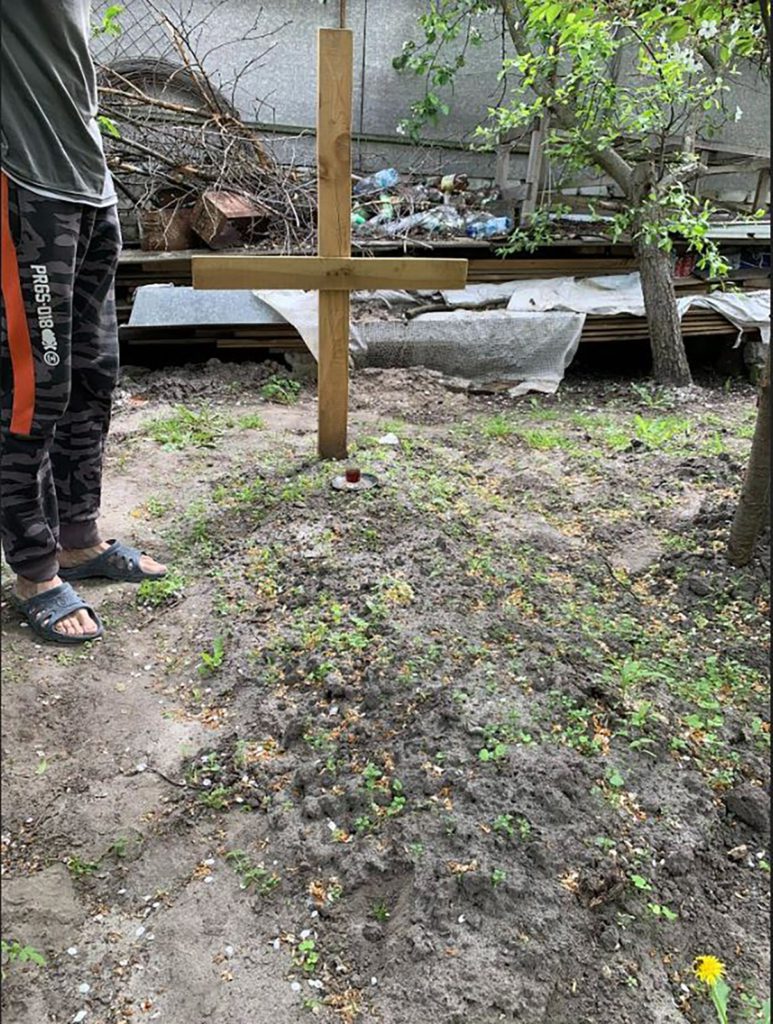
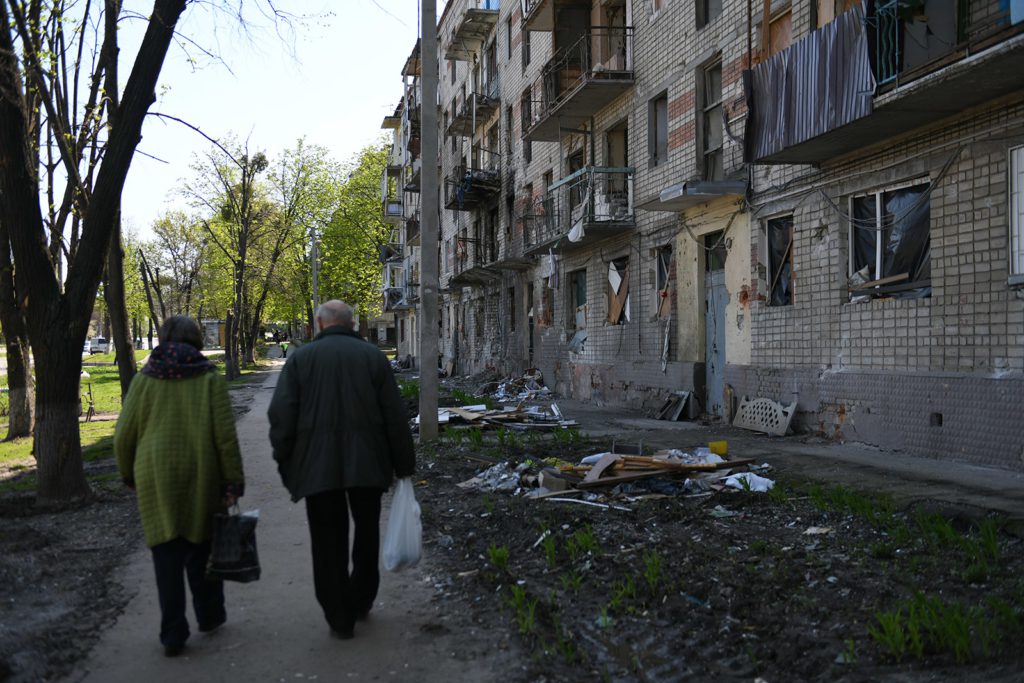
LEGAL ANALYSIS
International humanitarian law (IHL), or the laws of war, sets out legal rules that bind all parties to armed conflict, whether state armed forces or non-state armed groups. These rules aim to minimise human suffering in war and offer particular protection to civilians and others who are not directly participating in hostilities.
In situations of armed conflict, not all civilian casualties will be unlawful. However, deaths and injuries of civilians (and destruction of civilian objects) are an indication that something has gone wrong. They could be the result of a violation of the rules, even of criminal wrongdoing; or they could be the result of an accident, mistake or malfunction of a weapons system, or the incidental result of a lawful attack. Meaningful investigations are necessary to make these determinations, ensure accountability and redress for violations, and lead to corrective measures being taken in the future to avoid unnecessary harm to civilians.
Both Russia and Ukraine are parties to the Geneva Conventions and their Additional Protocol 1.39 These treaties, as well as the rules of customary international humanitarian law, are fully applicable to the international armed conflict currently taking place in Ukraine. All parties to that conflict must therefore respect these basic rules, which protect people during armed conflict. That means, among other things, taking all feasible precautions to spare the civilian population from the effects of military operations and allow safe passage for civilians fleeing the fighting.
The principle of distinction, one of the cornerstones of international humanitarian law, requires the warring parties to, at all times, “distinguish between civilians and combatants” and ensure that their attacksare directed against combatants and not against civilians.40 Anyone who is not a member of the armed forces of a party to the conflict is a civilian, and the civilian population comprises all persons who are not combatants.41 Civilians are protected against attack unless and for such time as they take a direct part in hostilities.42 In cases of doubt, individuals should be presumed to be civilians and immune from direct attack.43 Making the civilian population, or individual civilians not taking a direct part in hostilities, the object of attack is a war crime.44
The parties to the conflict must also distinguish between “civilian objects” and “military objectives” — i.e., between structures used for civilian purposes and those used for military purposes and direct their attacks only at the latter.45
The principle of proportionality, another fundamental tenet of IHL, prohibits disproportionate attacks, which are those “which may be expected to cause incidental loss of civilian life, injury to civilians, damage to civilian objects, or a combination thereof, which would be excessive in relation to the concrete and direct military advantage anticipated.”46 Intentionally launching a disproportionate attack (that is, knowing that the attack will cause excessive incidental civilian loss, injury or damage) constitutes a war crime.47
The repeated bombardments that killed hundreds of civilians and injured many more in populated residential neighbourhoods in Kharkiv are indiscriminate attacks which killed and injured hundreds of civilians and resulted in large-scale damage to civilian objects, and as such constitute war crimes. This is true both for the strikes carried out using cluster munitions – which are inherently indiscriminate and widely banned internationally – as well as those conducted using other types of unguided rockets, which are inherently inaccurate and produce wide area-effects, making them indiscriminate when used in the vicinity of concentrations of civilians, as well as unguided artillery shells that cannot be aimed at a specific target and have a margin of error of 100 metres or more. The continued use of such inaccurate explosive weapons to attack populated civilian areas – in the knowledge that they are repeatedly causing large numbers of civilian casualties (as has been widely reported from the first days of the conflict) -- may even amount to directing attacks at the civilian population, given the high likelihood of causing civilian deaths and injuries and the relatively low probability, in many instances, of striking military objectives and combatants.
No fixed military targets are known to have been located at or around any of the buildings that were struck (with the one exception detailed above, but it was more than 100 metres from the area that was struck), though at times Ukrainian forces fired (at Russian forces occupying villages north and east of Kharkiv) from mobile military position in those areas.
Russian forces cannot credibly claim to have been unaware that civilians were living in the targeted neighbourhoods. Even if those planning the attacks were somehow initially unaware of the large numbers of civilians present in the city when they launched the first attacks on the first days of the war, it would have quickly been made clear that civilians were being killed. Further, if there were military objectives in the areas Russian forces have an obligation to take necessary precautions to spare civilians and civilian objects, including to choose means and methods of attack with a view to avoiding, and in any event to minimizing, harm to civilians and civilian objects, and to give effective advance warning to civilians unless circumstances do not permit.48 And they are required to cancel any attack as soon as it becomes apparent that the objective is not a military one or that it may be expected to cause incidental loss of civilian life, injury to civilians, damage to civilian objects, or a combination thereof, which would be excessive in relation to the concrete and direct military advantage anticipated.49 Russian forces have failed to take any of these precautions. No effective warnings to civilians were given. And by choosing to use weapons that are by nature indiscriminate, and other explosive weapons with wide area effects, to attack populated civilian areas, they flouted both the obligation to take precautionary measure and the prohibition of indiscriminate attacks.
Justice and accountability
Amnesty International calls for justice processes to be as comprehensive as possible, ensuring that all perpetrators are brought to justice through independent, impartial, and fair trials for all crimes under international law. The rights of victims of crimes under international law must be at the forefront of investigations and prosecutions, and victims must be able to fully realise their rights to truth, justice, and reparations. All national and international institutions with jurisdiction over the crimes committed in Ukraine, including national authorities in Ukraine and the International Criminal Court (ICC), must take immediate steps to ensure that evidence is collected and preserved so that those most responsible are brought to account in fair trials. In addition, given the multiplicity of bodies working to collect and preserve evidence in Ukraine — and the likelihood of overlap — these bodies should coordinate appropriately with each other.50
The International Criminal Court is the most immediately viable forum for the investigation and prosecution of suspected perpetrators.51 Importantly, it has a mandate to pursue investigations into senior level military and political commanders and leaders, who lack immunity before it, and states parties are legally obliged to cooperate with it. In mid-May, the ICC Prosecutor announced that his office had deployed “a team of 42 investigators, forensic experts and support personnel to Ukraine to advance our investigations into crimes falling into the jurisdiction of the International Criminal Court … and provide support to Ukrainian national authorities.” He noted that this was “the largest ever single field deployment” by his office since its establishment.52
Ukraine has also commenced investigations into crimes under international law, and, as of this writing, has brought charges against 10 Russian soldiers for war crimes allegedly committed in Bucha and tried and convicted three soldiers, one accused of murder and two accused of firing artillery into Ukraine.53 However, the Ukrainian justice system appears to lack capacity to undertake such investigations to international standards.54
Download the report
References
1 “У Харкові чутно вибухи” (Explosions can be heard in Kharkiv), Тетяна Федоркова, 24 February 2022, https://suspilne.media/210079-u-harkovi-cutno-vibuhi-2/
2 Amnesty International previously documented a number of indiscriminate Russian strikes on populated areas of Kharkiv that took place in March and late February. See Amnesty International, "Ukraine: Russia’s cruel siege warfare tactics unlawfully killing civilians – new testimony and investigation," 1 April 2022.
3 Shelling of the city almost stopped at the end of April, when Russian forces were pushed back towards the Russian border. See: “Ukraine war: Russia pushed back from Kharkiv - report from front line”; BBC 11 May 2022; https://www.bbc.co.uk/news/world-europe-61378196. However, sporadic attacks have continued, including a devastating attack on 26 May which reportedly killed eight people and injured 17 near the 23 August metro station in the north of the city. Among the victims were five-month-old Mikhail Korostyliov and his father Mykolaii Korostyliov, 34. The baby’s mother, Oleksandra Korostyliova, was lightly injured in the attack. See: https://www.facebook.com/iklymenko.fb/posts/pfbid0QkCdw8qRbxoR8phgCzPisWByXtJZpBX47pK4gJQCEScABvxmCUuvhtmuBxHiNMmrl and: https://www.youtube.com/watch?v=i5ua6ZqACFM
4 Letter from Maxim Haustov, director of the Medical Department of the Kharkiv Regional Military Administration, to Amnesty International, n°02-03-09/508, 28 April 2022.
5 “Kharkiv was struck 65 times on Monday and 600 residence buildings have been destroyed so far, officials say,” CNN, 15 March 2022, https://edition.cnn.com/europe/live-news/ukraine-russia-putin-news-03-15-22/h_3799075fd4af25327b19f6496cbb1bc0
6 Some people preferred to have their patronym rather than their surname mentioned. Others neither. Several people said that a Ukrainian law applicable during wartime bars citizens from disclosing information about people and places affected by attacks from enemy forces. They may have been referring to Law No. 2160-IX, which came into effect in March 2022. See “Zelenskiy Signs Law Restricting Distribution of Ukrainian Military Information,” RadioFreeEurope, 28 March 2022.
7 Statement by Oleh Syniehubov, governor of Kharkiv Oblast, 8 March 2022, https://t.me/synegubov/2563
8 “About 30% of residents left Kharkiv,” Kharkiv City Council, 28 March 2022, https://city.kharkov.ua/uk/news/kharkiv-zalishili-blizko-30-zhiteliv-50209.html
9 “Scenes from Kharkiv: Battle wreckage, the boom of artillery, and people sheltering in the subway,” New York Times, 25 February 2022, https://www.nytimes.com/2022/02/25/world/europe/kharkiv-ukraine-military.html, and https://www.youtube.com/watch?v=PNHVXR90gEs
10 “Russian troops enter Ukraine's Kharkiv -Ukrainian official,” Reuters, 27 February 2022, https://www.reuters.com/world/europe/russian-troops-enter-ukraines-kharkiv-ukrainian-official-2022-02-27/“Ukraine is fully controlling Kharkiv - region governor,” Reuters, 27 February 2022, https://www.reuters.com/world/europe/ukraine-is-fully-controlling-kharkiv-region-governor-2022-02-27/
11 “Ukraine facing humanitarian crisis amid relentless Russian missile attacks,” Guardian, 2 March 2022, https://www.theguardian.com/world/2022/mar/02/ukraine-cities-bombardment-russia-attack-kyiv-kharkiv-russian-war-invasion
12 “See, for example, “Hanging on in a frontline Ukrainian ghost town,” France 24, 30 March 2022, https://www.france24.com/en/live-news/20220330-hanging-on-in-a-frontline-ukrainian-ghost-town; Обстріл Харкова: снаряд влучив у під’їзд житлового будинку (Kharkiv shelling: A shell hit the entrance of an apartment building), 26 April 2022, https://www.youtube.com/watch?v=PDKHRZF-5sY.
13 “Ukrainian troops holding destroyed village believe Russians withdrawing across border,” Reuters, 15 May 2022, https://www.reuters.com/world/europe/ukrainian-troops-holding-destroyed-village-believe-russians-withdrawing-across-2022-05-15/ “Ukrainian force begins evacuating from last Mariupol stronghold,” Reuters, 16 May 2022, https://www.reuters.com/world/europe/ukraine-counter-attacks-russian-forces-east-2022-05-16/
14 Several other people injured in the strike were taken to other hospitals.
15 See details in the Cluster Munition box
16 After several weeks in intensive care, Oksana's condition was improving slightly at the time of writing this report, but she tragically died on 11 June.
17 See "В результате обстрела пункта "Новой почты" в Харькове погибли 6 мирных жителей, 15 ранены – глава ОВА” (As a result of shelling of the Novaya Pochta checkpoint in Kharkiv, 6 civilians were killed and 15 wounded – the head of the OVA), Interfax Ukraine, 24 March 2022.
18 See “Обстрел Слободского района Харькова: 7 погибших, 34 раненых” (Shelling of the Sloboda district of Kharkiv: 7 dead, 34 wounded), Ukrainska Pravda, 3 April 2022, https://www.pravda.com.ua/rus/news/2022/04/3/7336933/. Amnesty International spoke to witnesses who had seen four people killed and more than a dozen injured, and had heard of others who had been killed and injured. Residents of buildings 3 and 3A told Amnesty International that the man and woman who were killed by the benches in front of the building were local, but they did not know their names.
19 Residents said that the man who was killed in his car was had a volunteer badge but was not local and they did not know his name.
20 The explosion of several cluster munitions on the main road was caught on the security camera of the nearby checkpoint. See: https://www.facebook.com/100036052672011/videos/693926275137452/
21 This was not the first strike on the village. A week earlier, on 21 April, Liubov Aleksandrova, age 69, suffered multiple fractures and lacerations to her arms and legs from shrapnel from a rocket strike, while in her garden
22 The Russian PTM-1S (ПТM-1C) is a dispenser-ejected, scatterable, high-explosive (HE) landmine with a random self-destruct feature. While Russia classifies it as an anti-vehicle landmine, it can be classified as a victim-operated anti-personnel landmine under the Anti-Personnel Mine Ban Convention, because of the fact that it can be triggered by an accumulation of human-weighted pressure inputs. The landmine can be scattered from helicopters or dispersed from Grad (122mm) and Uragan (220mm) rockets. See PTM-1S Landmine, Collective Awareness to UXO (undated), https://cat-uxo.com/explosive-hazards/landmines/ptm-1s-landmine
23 Objective TV, 12 April 2022, https://www.objectiv.tv/objectively/2022/04/12/ustanovili-kakimi-imenno-snaryadami-obstrelyali-harkov-11-aprelya/
24 These are large multi-storey buildings hosting more than 100 apartments each and residents do not know each other. Moreover, after the initial strikes many residents fled the city, including relatives, friends and neighbours of the victims.
25 “Land Mines on a Timer, Scattered over a Ukrainian Town,” New York Times, 8 April 2022, https://www.nytimes.com/2022/04/08/world/europe/ukraine-russia-land-mines.html
26 The 9N210 and 9N235 cluster munitions appear nearly identical from the outside, and differ only in the length of the time delay of their self-destruct feature and the size of the pre-formed pellets in the frag sleeves. See Russian 9N235 submunitions documented in Ukraine, Armament Research Services, 13 March 2022.
27 Each 9N235 munition contains approximately 360 smaller pellets, nominally weighing 0.75 grams, and approximately 96 larger pellets weighing 4.5 grams. Each 9N210 munition contains approximately 400 pellets, all weighing 2.0 grams. See Russian 9N235 submunitions documented in Ukraine, Armament Research Services, 13 March 2022.
28 International Committee of the Red Cross, Customary International Humanitarian Law, Vol 1: Rules (ICRC, Customary IHL Study), Rule 71: Weapons That Are by Nature Indiscriminate.
29 The Convention is available at: https://geneva-s3.unoda.org/static-unoda-site/pages/templates/anti-personnel-landmines-convention/APLC%2BEnglish.pdf. It has been signed by 164 states, including Ukraine but not Russia.
30 The figure is from Governor Oleh Syniehubov, quoted in “Kharkiv, Ukraine’s second city, adjusts to life with half its pre-war population”, The Economist, 30 May 2022.
31 An Amnesty International researcher found remnants and shrapnel from Grad rockets and artillery shells all around the affected areas, as well as remnants of Uragan rockets. 32 For example, a full salvo of 40 Grad rockets produces a lethal area of 600m x 600m. See 122 mm BM-21 Multi Barrel Rocket Launcher (MBRL), Geneva International Centre for Humanitarian Demining (GICHD), https://characterisationexplosiveweapons.org/studies/annex-a-122-mm-mbrl/
33 A witness at the site told Amnesty International that two people were killed and another witness said she had seen several people injured after the strike.
34 See image (verified and geolocated) of the rocket at: https://www.newsroom.kh.ua/news/v-harkove-na-klochkovskoy-upali-reaktivnye-snaryady-est-ranenye
35 Two residents also said that Sergiy Tiyglo, an older resident of 36 Buchmy Street, and his mother were killed on 3 March in shelling. They were killed in front of the entrance while he was trying to evacuate her in their car.
36 ICRC, Customary IHL Study, Rule 23. Location of Military Objectives outside Densely Populated Areas.
37 A howitzer is a short cannon used to fire projectiles at medium muzzle velocities and with relatively high trajectories.
38 Each KPOM-2 canister contains 4 POM-2 anti-personnel landmines, which are prohibited under the Mine Ban Treaty. See KPOM-2, Fenix Online (undated), https://www.fenix-insight.online/munition/dispenser/kpom-2. This area was never under the control of Russian forces, and these mines are known to be in the possession of Ukrainian forces. See Ukrainian-operated UMZ mine laying system in Ukraine, Armament Research Services, 3 March 2015, https://armamentresearch.com/ukrainian-operated-umz-mine-laying-system-in-ukraine
39 Both Russia and Ukraine are states party to the four Geneva Conventions of 12 August 1949 and their Additional Protocol of 1977 relating to the Protection of Victims of International Armed Conflicts (Protocol I). Many of the rules in these conventions are also part of customary international law.
40 ICRC, Customary IHL Study, Rule 1. See also Protocol Additional to the Geneva Conventions of 12 August 1949, and relating to the Protection of Victims of International Armed Conflicts (Protocol I), Article 48.
41 ICRC, Customary IHL Study, Rule 5; see also Protocol I, Article 50.
42 ICRC, Customary IHL Study, Rule 6; see also Protocol I, Article 51(3).
43 Protocol I, Article 50(1).
44 ICRC, Customary IHL Study, Rule 156, p. 591; Protocol I, Article 85(3)(a); Rome Statute of the ICC, Article 8 (2)(b)(i).
45 ICRC, Customary IHL Study, Rule 7; Protocol I, Articles 48 and 52.
46 ICRC, Customary IHL Study, Rule 14; Protocol I, Articles 51(5)(b) and 57.
47 ICRC, Customary IHL Study, Rule 156, pp. 599-601; Protocol I, Article 85(3)(b); Rome Statue of the ICC, Article 8(2)(b)(iv).
48 Additional Protocol I, Article 57(2)(a)(ii) and 57(2)(c).
49 Additional Protocol I, Article 57(2)(b).
50 In addition to domestic judicial processes and the ICC, there is also a UN-established Independent International Commission of Inquiry on Ukraine that has a mandate to, among other things, collect and analyse evidence of international human rights and humanitarian law violations in Ukraine. See UN Human Rights Council, Resolution 49/1, UN Doc. A/HRC/RES/49/1 (7 March 2022).
51 Ukraine is not a party to the Rome Statute of the International Criminal Court (ICC), but it has accepted the court’s jurisdiction over alleged crimes committed on its territory since November 2013. On 28 February 2022, the ICC prosecutor announced he would seek authorisation to open an investigation into alleged crimes in Ukraine. Statement of ICC Prosecutor on the Situation in Ukraine, 28 February 2022.
52 ICC Prosecutor Karim A.A. Khan QC announces deployment of forensics and investigative team to Ukraine, welcomes strong cooperation with the Government of the Netherlands, ICC, 17 May 2022, https://reliefweb.int/report/ukraine/icc-prosecutor-karim-aa-khan-qc-announces-deployment-forensics-and-investigative-team-ukraine-welcomes-strong-cooperation-government-netherlands
53 Two Russian soldiers plead guilty in new war crimes trial in Ukraine, Reuters, 26 May 2022; https://www.reuters.com/world/europe/two-russian-soldiers-plead-guilty-new-war-crimes-trial-ukraine-2022-05-26/
54 See, for example, Amnesty International Report 2021/22, Index: POL 10/4870/2022 (chapter on Ukraine); Freedom House, Freedom in the World 2022.

